Business portal company administrator guide
Overview
The Business Portal is our Feature Management Portal, often referred to as Configuration Portal. It allows users to configure and manage communications features and settings, based on their profile level.
Additionally, the portal can be used by Company/Site Administrators as an ordering portal to:
- Add new Users to an existing Site
- Modify an existing Users licenses, including changing, adding or removing
- Cease an existing User or Users add-ons
- Change a User’s phone number
Business Portal can be logged onto from the following devices:
- Desktop (Windows/MAC) – Preferred
- Tablet
- Smartphone
Business Portal supports the follow browsers:
- Internet Explorer 8.0 and higher
- Firefox
- Chrome
- Safari
The Business Portal allows a Company Administrator to perform the following tasks:
- Manage account details and passwords of Users, including password resets
- View a Company and Site/s dashboard
- View Users’ devices, including customise, and add/modify additional devices
- Manage groups
- Manage Site features
- Manage User features including removal/restriction of features
- Add new Users to an existing Site (where enabled)
- Modify an existing Users licenses, including changing, adding or removing (where enabled)
- Cease an existing User or Users add-ons (where enabled)
- Change a User’s phone number (where enabled)
The Business Portal allows a Group Administrator to perform any or all of the following tasks, depending on what privileges they have been assigned by the Company Administrator.
- Manage account details and passwords of Users, including password resets
- View a Company and Site dashboard
- View Users’ devices and add/modify devices
- Manage groups
- Manage Site features
- Manage User features including removal/restriction of features
- Add new Users to an existing Site (where enabled)
- Modify an existing Users licenses, including changing, adding or removing (where enabled)
- Cease an existing User or Users add-ons (where enabled)
- Change a User’s phone number (where enabled)
Throughout this document the terms User and Employee will be interchanged, but both mean the same thing – a person using the service and whom has access to the Business Portal.
This document is intended for ic-talk 3 Company/Group Administrators and their Sub-Reseller/Dealer Administrators. It provides detailed guidance on the configuration and management of the service at a Company, Site and User level, as well as guidance for ordering and modifying Users.
The following documents will also need to be referred to, available on the knowledge base
- WHC Business Portal CP Administrator User Guide
- WHC Business Portal End User Guide
You will have been provided a username/domain/password from IC when you have purchased the product.
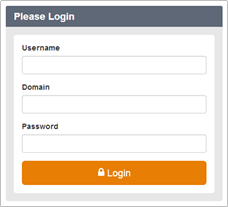
If Company Administrators are also Users of the service, then they will receive the URL, along with their Usernames and Passwords, in their welcome email.
Passwords will expire every 90 days and a User will be asked to enter a new password once this period has expired. When changing this password, a User will not be able to use the previous password. When entering a new password the following rules must be adhered to:
- Password Length: 8 characters
- Convention: 1 uppercase letter, 1 number and 1 special character.
Password resets for Company Administrators can only be rectified by IC. If you need to reset a password, please contact your us.
Group/User Administrator Reset
If a Group Administrator or User needs a password reset, this can be completed by a Company Administrator. Simply log into the Business Portal using your Company Administrator credentials, locate the Site, select Employees, locate the User and click on Select.
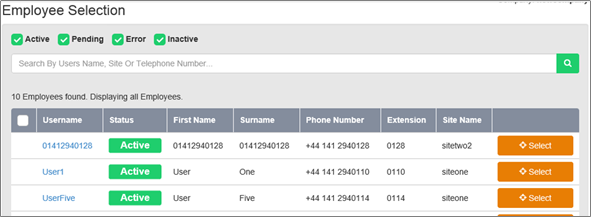
Click on Profile from the left-hand administration bar.
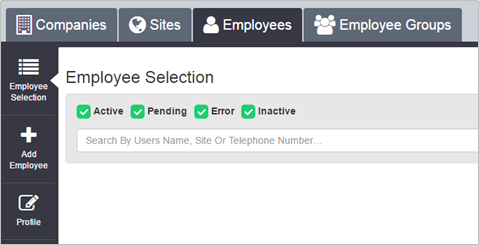
Select Auto generate and email password to reset the password and send this directly to the registered user.
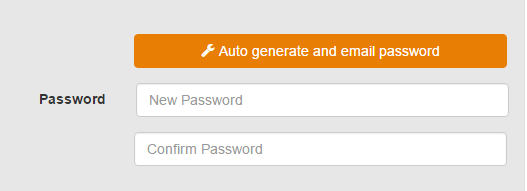
Once selected this will display the following warning message, please select OK to proceed.
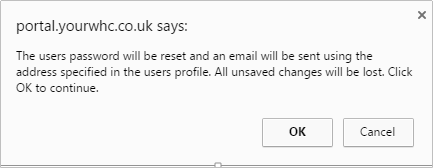
Once selected this will display the following Success message indicating the password has been reset and sent.

If you enter the wrong credentials into the portal 3 times in a 4 hour period, your account will be locked. This account will then stay locked for 4 hours, after which you can then enter the correct credentials.
Alternatively you can contact your administrator, with a role of CP, and they can use the Force Unlock option to unlock this ahead of the 4 hour period, and if needed reset the password.
Company Administrator Force Unlock
If you lock yourself out of your account you will need to contact us and we can unlock this for you.
Group/User Force Unlock
If a Group Administrator or User needs their account unlocked, this can be completed by a Company Administrator. Simply follow the steps identified in the Password Reset section above to locate the User, then select the Force Unlock option.
Once selected this will display the following warning message, please select OK to proceed.
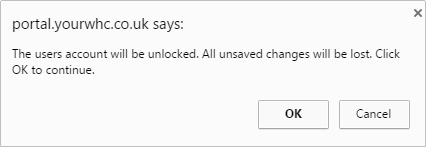
Once selected this will display the following Success message indicating the account has been unlocked. Please note, no email is sent when you unlock an account.

Saving the Business Portal as a Home Screen on IOS
Access Business Portal on your iOS device and you can save it to the home screen. By doing so, it effectively behaves like an app:
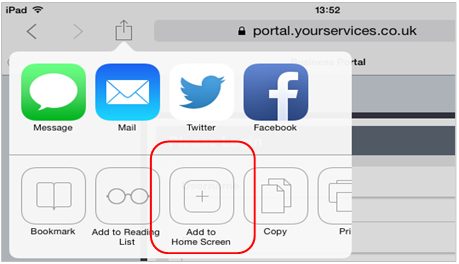
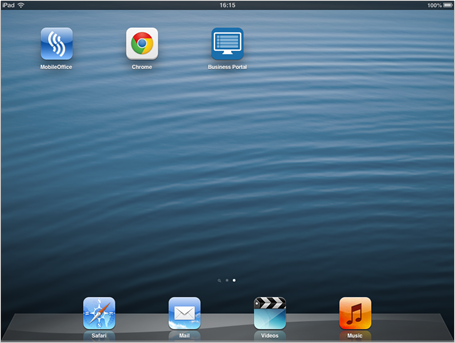
The following screenshots are used to provide a quick overview of the high-level functionality of the portal at a Company/Group Administrator level.
The Business Portal uses tabs to navigate to the different sections of the portal and by default the landing page is the Company dashboard for Company Administrators. You can use the top navigation tabs to manage Sites, Employees and Employee Groups. The side navigation tabs (left-hand side) provide you with administration and management options within the selected Company, Site, Employee or Employee Groups.
Company Dashboard & Quick Statistic Tiles
As Company Administrator, you will be presented with the following dashboard when you log in. This view will provide you with a visual quick stats section, displaying the following key information:
- Number of Active Sites
- Number of Active Employees
- Number of Company Admins
- Add Employee option (where enabled)
- Call Logs
- Recent Activity
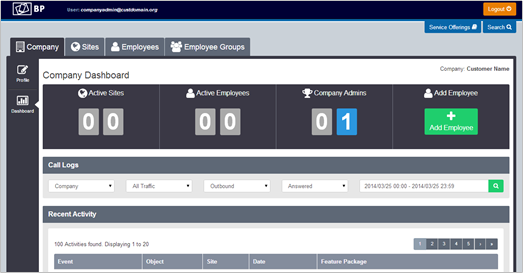
Site Dashboard & Quick Statistic Tiles
If a Group Administrator is created then they will not see the Company dashboard, but may see the Site Dashboard, Site Selection or Employees area. This is dependent on whether the Group(s) that they are administering is also a Site. A Group Administrator can only manage features within the group they have been assigned to.
Assuming the Group Administrator is allowed to administer the Site, the following will be displayed:
- Number of Active Employees
- Number of Auto Attendants created
- Number of Call Centres created
- Number of Hunt Groups created
- Voice Recording (where enabled)
- Call Logs
- Feature Summary
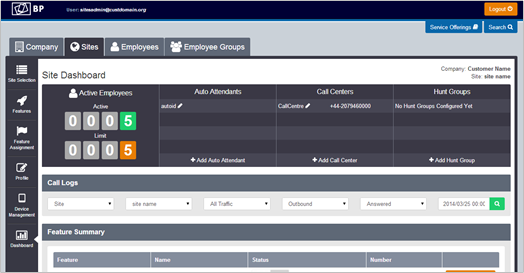

If you have Voice Recording enabled then the dashboard display will look slightly different and include a section called ‘Voice Recording’ directly below the tiles, as per the image below.

Employee Dashboard & Quick Statistic Tiles
An administrator is able to log into the Employees Dashboard which will show them the following key information:
- Voicemail Notifications – Unread and Read
- Missed Calls – Number, Date and Time
- Dialled Calls – Number, Date and Time
- Received Calls – Number, Date and Time
- Recorded Calls – Last 10 recorded calls, calls in progress (only if enabled). Click through to Voice recordings is disabled for CP Administrators for data protection.
- Call Logs – user level call data and analysis
- Quick Feature Management – top features
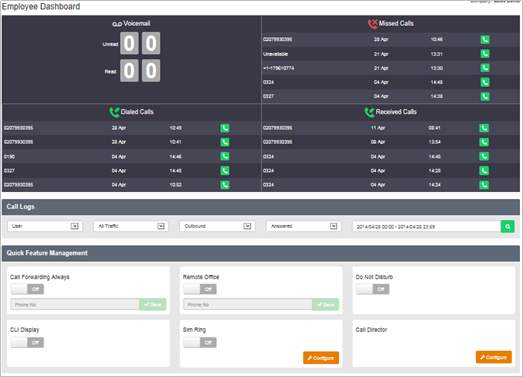
The Service Offering menu lists the Feature Packages that are available for Sites and Employees. This can be found at the top-right of the page:

A Feature Package represents a specific collection of service features. You can use this information to determine which Feature Package you have assigned to each Employee and Company. Optional Add-On Features can also be viewed here.
The Service Offering tab will offer up different information, depending on which tab has been selected. This is summarised below:
|
Object |
Service Offering Tab |
|
Company |
Displays all available Site and Employee Feature Packages and Add-Ons Company-wide |
|
Site |
Displays the Site Feature Package and Add-Ons assigned to the Site and all Employee Feature Packages and Add-Ons that are available for Employees under the Site |
|
Employee |
Displays the Feature Package and any Add-Ons assigned to the Employee |
As a Company Administrator you will be presented with the following view:
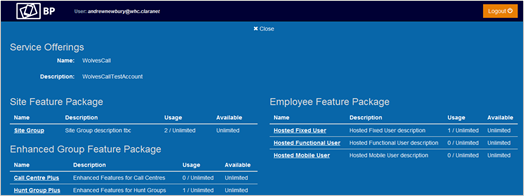
To then view the features within a package you simply need to click the package which will then present the following views:

You can use the Search function at the top of the page to search on a number of objects within the same company:

It offers a dynamic search facility across the following fields:
- Username
- Firstname
- Surname
- Phone Number
- Site Name
Administrators simply need to type in the criteria (full or partial) and it will list all matches:

General Portal Views and Information
As a Company Administrator you can view features at a Site or End User level.
From the Site or Employees tab, select a site or employee and you will then be able to open the Features tab on the left side. This will, open up the features view:
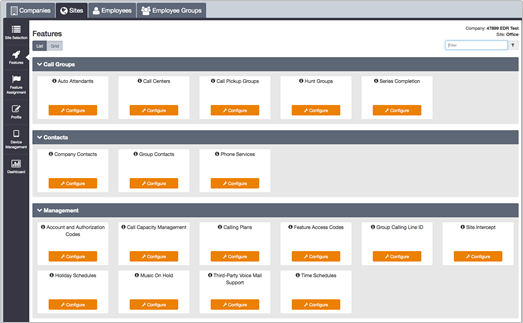
You have the option of viewing these as either a List or Grid view:



For a Feature description and more information, hover over the Icon. A brief summary will appear:

Some screens have filter options which allow you to dynamically filter the options displayed on the scree

Additionally, the Site Selection, Employees Selection and Group Selection pages have search options which allow you search the through the following data:
Site Selection:
- Site Name
Group Selection:
- Group Name
Employee Selection:
- Username
Firstname
- Surname
- Phone Number
- Site Name
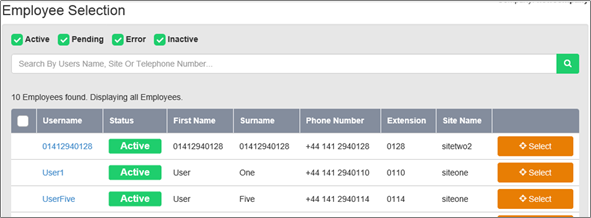
Dashboard Description – Company
Quick Statistic Tiles
Select a Company and click on the Dashboard to be presented with a visual quick stats section that will display the following:
- Number of Active Sites
- Number of Active Employees
- Number of Company Admins
- Add Employee option (if enabled)

Call Logging provides companywide call records, comparison and analytical tools for tracking and improving the efficiency and effectiveness of business communications.
An intuitive, feature rich interface allows you to visualize trends and patterns, zoom in on detailed data or view key headline information at a glance. Call Logging is accessed via the Dashboard in the Business Portal from anywhere and on any device via a Web Browser and Internet connection.

The search bar may display different options depending on your account privileges. You are able to build your search by first selecting your criteria from the options boxes and then secondly by clicking the magnifying glass to submit the search and view the results. The Graph and Compare Views, List View, Type View and Top 10 Views (detailed below) will display the results based on your chosen search. There is a maximum delay of approximately 15 minutes for new calls to be displayed.
The search criteria available are:
- Object - Company, Site, User (by Username), Business Number (by full or partial telephone number), Calling Number (by full or partial telephone number)
- Traffic - All Traffic, International, Premium Rate, Non-Geographic, Mobile, National, Off-Net, On-Net
- Direction - Outbound, Inbound, Any
- Status - Answered, Unanswered, Any
- Date Range
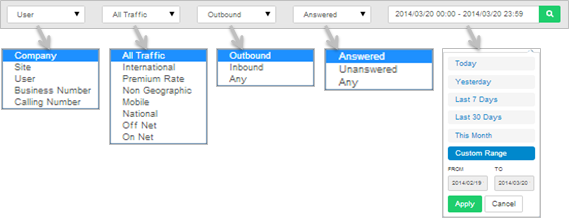
Graphical View and Compare
When your results are returned, the Graphical View displays total calls or minutes for the current month by hour, day, week or month. You can zoom into the graph for monthly down to hourly views and pan across the graph to move to the previous or next period of time. You can hover over each data point dot on the graph to display the values.
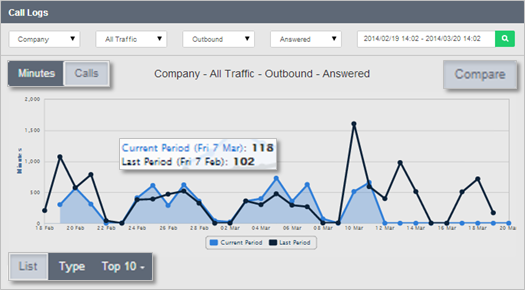
- Zoom between Hourly, Daily, Weekly and Monthly data
- Use the interactive graph to pan and hover for more data
- A comparison feature overlays the previous month’s data results, allowing you to analyse patterns and trends
- You can switch between the views detailed below using the View Buttons.
List View
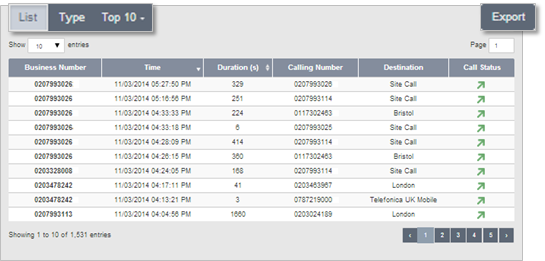
The List View provides individual call information on the results of your search including the Business Number, Time, Duration, Calling Number, Destination and Call Status.
You can order the List View results by ascending or descending Time or Duration by clicking on the corresponding column title. Browse the data by selecting the number of entries to display and/or by navigating through the result pages
Type View

The Type View allows you to instantly compare different types of calls to provide key information including the amount of Off-Net calls versus On-Net calls, Inbound vs. Outbound and Answered vs. Unanswered. The Type View displays the percentage split of total minutes and total calls for each call type. This is a useful feature to instantly view how many of your calls are On-Net (often within the Company or between Sites and free of charge) versus Off-Net calls to people outside of your Company. It allows you to see how calls are being handled and monitor performance by viewing the incoming and outgoing call split and percentage of answered and unanswered calls.
Top 10 View
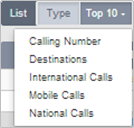
The Top 10 View provides the 10 highest results based on your search and top 10 category selection. For example, this allows you to see the top 10 destinations or numbers involved in calls across your whole Company, individual users or Groups.
Click the Top 10 View button and select your category from the list of Calling Number, Destinations, International Calls, Mobile Calls and National Calls. For example, if your search was for all outbound, answered or unanswered calls for a Site and you select the top 10 International Calls, then the Top 10 View will display the top 10 most frequent international numbers being dialled by that Site and all of its Employees.
This is a useful feature to instantly view what regions a marketing campaign is targeting, which of your Customers are called or call you the most, the most popular international destinations, which Customers call Customer service the most and which Employees answer the most calls to these numbers etc.
The top 10 view allows you to see what the most popular calls are being made and received, increase business effectiveness and reduce costs.
Export Tool
The export tool allows you to export the current data in the chosen search and view as a CSV file. Click the Export button - this will automatically download all of the data in the current view in comma-separated values format.
The Recent Activity section of the Company Dashboard shows the recent provisioning activity for Sites, Employees and specific Site Features such as Call Centres that generate provisioning events. These events include activating, modifying and deleting Employees, assigning/removing Feature Packages from Call Centres and Hunt Groups. The table will show the last 100 events and after 2 years entries will be removed.
The information on each event shows the Event Type (e.g. Create Registration), the Object (e.g. its Username), the Site for which the event occurred, the Date the event occurred and any Feature Package assigned to the Object.
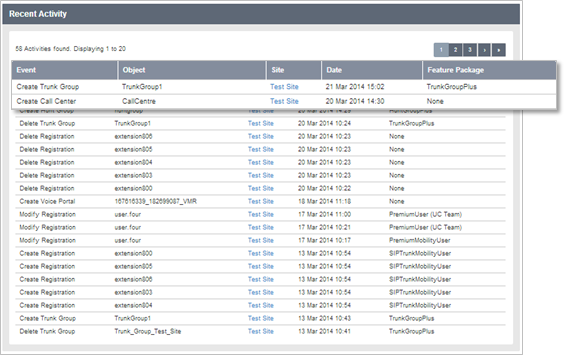
Please note, this section will not display changes made within features, i.e. a User changing their Simultaneous Ring setting.
A Company Administrator clicking onto a Site dashboard, or a Site administrator logging in, will be presented with the following visual quick stats:
- Number of Active Employees
- The limit of Employees (set by the CP Administrator in Business Zone)
- List of Auto Attendants including a shortcut to create a new one
- List of Call Centres including a shortcut to create a new one
- List of Hunt Groups including a shortcut to create a new one
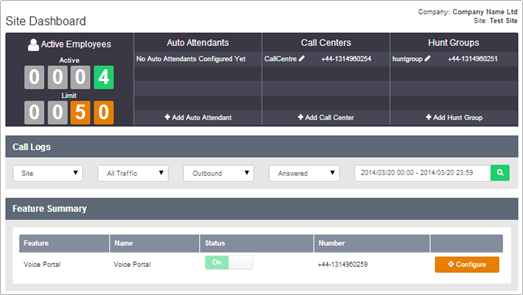
The Site Dashboard contains a section on Voice Recording where the CP Administrator has enabled this. This is sectioned into 4 areas:
- Total Subscribers
- Details

A Total Subscribers screenshot can be seen below and displays a total count of how Users are having their calls recorded. If the Details button is selected, this will open up the Call Recording portal in another window.

From here the Company and Group Administrator may see calls, play calls, delete calls and manage their Voice Recordings. Please review the Voice Recording Application Guide for further details on how to use this.
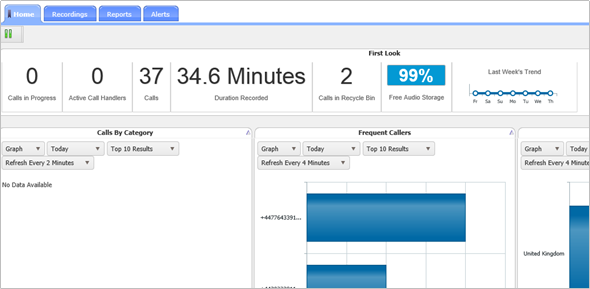
Call Logging provides a Sites call records, comparison and analytical tools for tracking and improving the efficiency and effectiveness of business communications. The function works the same as described above in the Company section.
This allows the Company Administrator to manage the Company Features (SIPT only), Company Profile, view the Company Dashboard and use the Search Tool.

When you select the Company tab you will be presented with a left-hand side bar, which provides administrative functions for that Company, as per the screenshot:
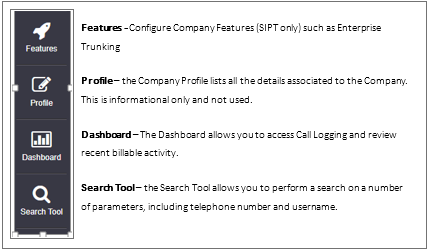
Features
Select this tab to configure Company features:

As a Company Administrator, you can configure the features for a Company. At this time there is only 1 feature Company configurable feature on the platform:
- Enterprise Trunks - used for SIP Trunking configurations only.
Click the Configure button next to the Company Feature that you wish to configure.

Profile
This section is not used so please do not make any changes in here.

Dashboard
This section is has already been explained in the dashboards section of this guide, above.

Search Tool

This section is used to perform a search across the Company by IP Phone MAC Address, Telephone Number and Name.
Once logged into the Business Portal you will see the Search Tool icon in the left-hand panel. Once you select Search Tool you will be taken to the next screen where you can use the Search by dropdown to perform either of the searches shown below, and described in the next sections.
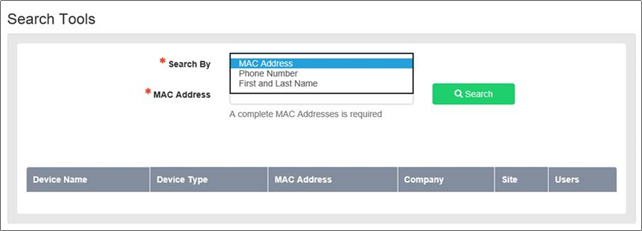
If you want to locate a specific IP phone device to see which Site or User it belongs to, you can perform a Companywide MAC address search.
- Select MAC Address from the Search By parameter.
- Input the MAC address of the device into the MAC Address field, all in uppercase.
- Select the Search button to perform the search

- If the device is found it will return a table similar to the one below, listing the Company and Site that it is allocated to. If the device is allocated to a User the Users column will be populated with view which acts as a hyperlink. If it allocated to a site but not a user then the Users column will say none.

- Select the view hyperlink button to open up an informational pop-up window which will then display further details on the user behind the device.

- Selecting the hyperlink in the Username column will take you to the Employee Service Settings
- Please note, if you perform a search and a match is found, but it is within a Company you do not have permission to view, you will get a message stating you do not have permission. This occurs because the search is performed platform wide.
Search by Telephone Number
If you want to locate a specific telephone number to see which Site, Enhanced Group Function (EGF) (Hunt group etc) or User it belongs to, you can perform a companywide telephone number search.
- Select Phone Number from the Search By
- Input the phone number into the Phone Number field, which will accept E164 format (+44xx) or national format (0203xx).
- Select the Search button to perform the search
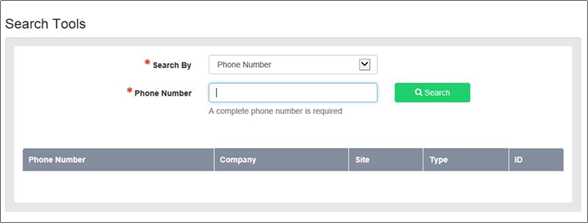
- If the telephone number is found it will return a table similar to the one below, listing the Company and Site that it is allocated to as well as if it allocated to a user or EGF. If the device is allocated to a user the Type column will be populated with the term User. If it allocated to a Hunt Group or similar group function then the Type column will be populated with the term EGF.

- Selecting the hyperlink in the ID column will take you to the Employee Service Settings
- Please note, if you perform a search and a match is found, but the number is not assigned to an EGF or User, you will get a message stating that.
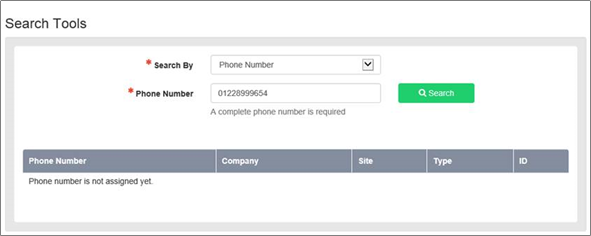
- Please note, if you perform a search and a match is found, but it is within a Company you do not have permission to view, you will get a message stating you do not have permission. This occurs because the search is performed platform wide.
Search by Name
If you want to locate a specific user by name to see which Site they belong to, or even which telephone number they have, you can perform a companywide name search.
- Select First and Last Name from the Search By
- Input the First Name into the First Name field and Last Name into the Last Name field, which will support wildcard searches. The Company field is optional and will limit the search to the company specified.
- Select the Search button to perform the search

- If the user is found it will return a table similar to the one below, listing the Company and Site that it is allocated to as well as the user’s phone number which will appear as a hyperlink. The filter button is free text and will allow you to further refine your search.

- Selecting the hyperlink in the User column will take you to the Employee Service Settings
Bulk Feature Management
Select this tab to duplicate feature settings from a reference Site or User to other target Sites and Users.

Once logged into the Business Portal you will see the Bulk Feature Management icon in the left-hand panel. Once you select Bulk Feature Management you will be taken to the next screen where you can start a new job or view any historical jobs.

To start a new job click on the +Add button which will then enable you to create a bulk mapping job for either Site or User (employee) features

Bulk Feature Management is supported on the following Site Features:
Auto Attendant
Add After Hours Greeting media, duplicate to all target Sites and enable.
Add Business Hours Greeting media, duplicate to all target Sites and enable.
- Call Centre
Add Entrance Message media, duplicate to all target Sites and enable.
Add Comfort Message media, duplicate to all target Sites and enable.
Add On Hold Message media, duplicate to all target Sites and enable.
Add Overflow Message media, duplicate to all target Sites and enable.
- Company Contacts
Enable and duplicate contacts across all target Sites
- Group Contacts
Enable and duplicate contacts across all target Sites
- Holiday Schedule
Enable and duplicate schedule across all target Sites
- Music on Hold File
Add MoH media, duplicate to all target Sites and enable.
- Music on Hold Configuration
Enable and duplicate settings across all target Sites
- Phone Services
Enable and duplicate across all target Sites
- Time Schedule
Enable and duplicate schedule across all target Sites
Bulk Feature Management is supported on the following User Features:
- Call Forwarding
Enable and duplicate settings across all target Users.
- Phone Services
Enable and duplicate across all target Users
- Pre-Alerting Announcement
Add custom media, duplicate to all target Users and enable.
- Pre-Alerting Configuration
Enable and duplicate settings across all target Users
- Voicemail Audio File
Add custom media, duplicate to all target Users and enable.
- Voicemail Configuration
Enable and duplicate settings across all target Users
- Voicemail Configuration
Enable and duplicate settings across all target Users
Bulk Feature Management – Site Features
Insert a name for the job and select the Site radio button.

The next step is to select a reference Site that you want to copy features from. Type in the name followed by the search magnifying glass, or to search all simply select the green magnifying glass button.

Select the radio button next to the reference Site followed by the Next button.
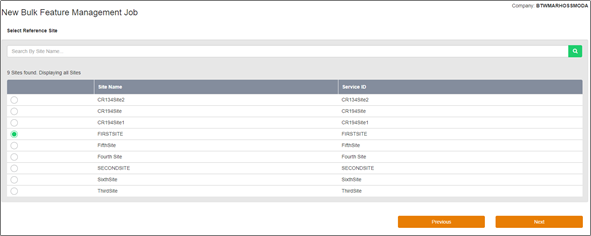
Select single or multiple target Sites that you want to copy features to. Type in the name followed by the search magnifying glass, or to search all simply select the green magnifying glass button.
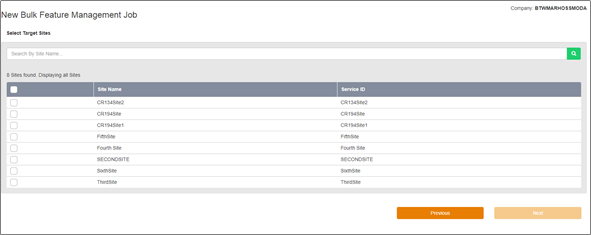
Select the radio button/s next to the reference Site/s followed by the Next button.

The page will then present you with all of the available features that can be used as part of Site Bulk Feature Management. Please note it will only show features that have been configured/enabled on the reference Site.

Configure the features as needed, described further down in this document, then when you are ready simply click the Next button at the bottom of the page. The information icon next to each feature name provides more information on what can be configured.

You will then be presented with a summary page. Click on Submit to start the job.

You will then be returned to the main page where you will see the job with a status of Not Started.

Once complete successfully the status will change to Completed.
Selecting the Job Name hyperlink will provide you with a modal showing you the status of each of the setting changes.
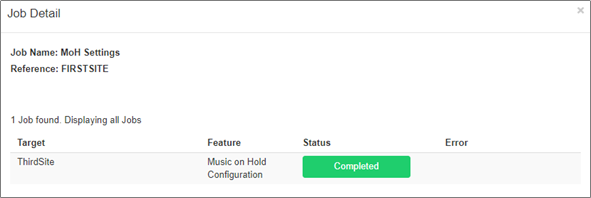
Throughout the process the status’s you may see are as follows:
- Not Started
- In Progress
- Completed
- Error
When a job errors it does not mean the job has necessarily failed, it could be that these mappings already exist. Select the Job Name hyperlink to review the modal.

In this example you can see that certain elements already existed or the names were the same so the job did not attempt to overwrite these.
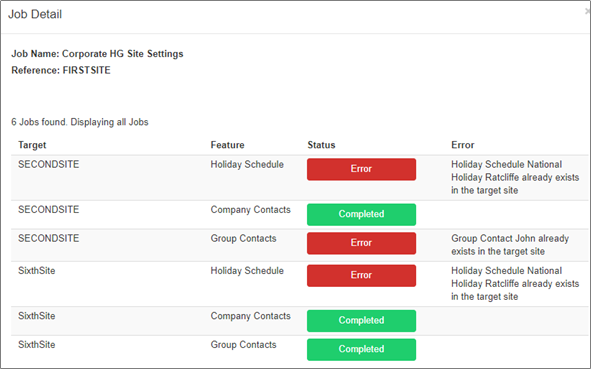
You can clear a job at any time by selecting the radio button next to the job, followed by delete. Please note this simply removes the reference to the job from here and does not back the settings out.
Mapping Custom Audio to Group Features
To upload custom audio files to the following supported features, select the radio button against each item.
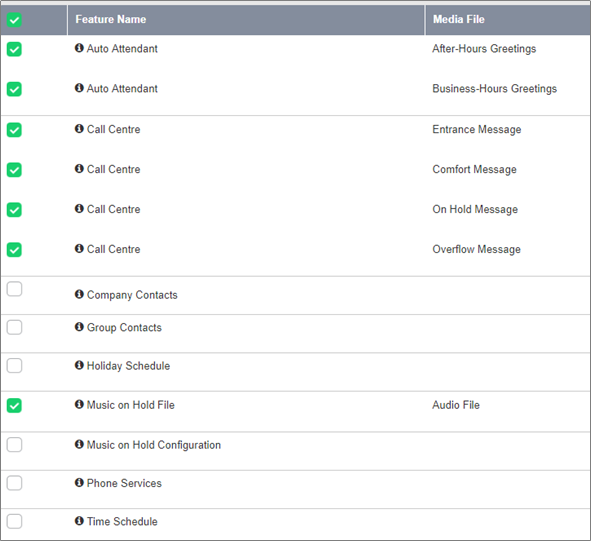
Select the Choose File button which will open up a new window allowing you to select a local audio file but don’t forget the file standard must match the supported type, as detailed in the Site Features guide.

Once uploaded, the Current Selection parameter will show the file. If this is not correct you can select the [clear] button to remove this.
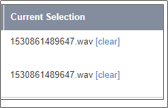
If you have other features to configure then carry on, if not select the Next button at the bottom of the page to complete the job. Please note Auto Attendants and Call Centres require the feature to be enabled and configured on both the reference Site and the Target site as here we are simply copying audio files to them. If they are not enabled at the Site you will see an error message similar to the one below.

Mapping Feature Settings
To copy other supported feature settings from one Site to another, select the radio button/s. This will copy all settings from the reference Site to the target Site/s for any of the following supported features:

If you have other features to configure then carry on, if not select the Next button at the bottom of the page to complete the job.
Bulk Feature Management – User Features
Insert a name for the job and select the Employee radio button.

The next step is to select a reference User that you want to copy features from. Type in the name followed by the search magnifying glass, or to search all simply select the green magnifying glass button. Please note ‘search all’ is limited to 10 users only, if there are more it will not return any results.

Select the radio button next to the reference User followed by the Next button.

This page will show all Users across all Sites, but can be filtered by Site using the dropdown or typing into the filter box. Select single or multiple target Users that you want to copy features to, followed by the +Add button

The target Users will then appear in the bottom box. If you have copied over any incorrectly, simply use the Remove button. If you are happy to proceed then select the Next button.

Select the radio button/s next to the reference User/s followed by the Next button.
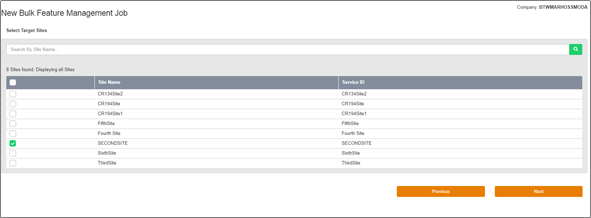
The page will then present you with all of the available features that can be used as part of User Bulk Feature Management. Please note it will only show features that have been configured/enabled on the reference User.
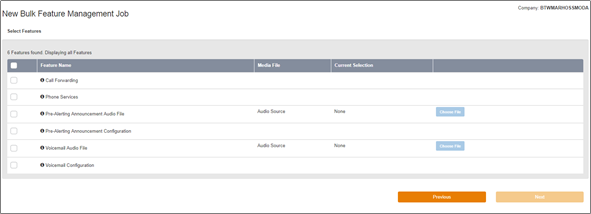
Configure the features as needed, described further down in this document, then when you are ready simply click the Next button at the bottom of the page. The information icon next to each feature name provides more information on what can be configured.

You will then be presented with a summary page. Click on Submit to start the job.

You will then be returned to the main page where you will see the job with a status of Not Started.

Once complete successfully the status will change to Completed.

Selecting the Job Name hyperlink will provide you with a modal showing you the status of each of the setting changes.
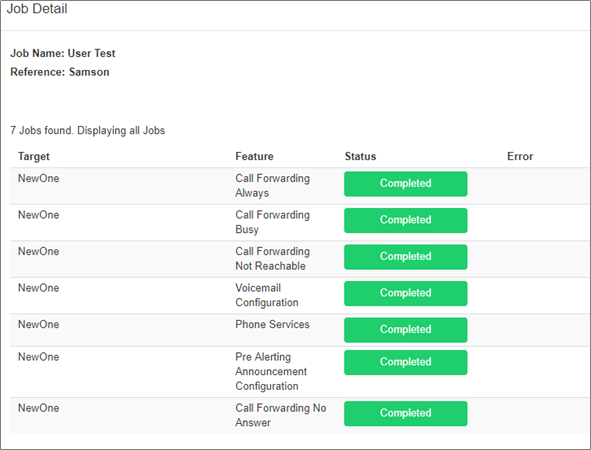
Throughout the process the status’s you may see are as follows:
- Not Started
- In Progress
- Completed
- Error
When a job errors it does not mean the job has necessarily failed, it could be that these mappings already exist. Select the Job Name hyperlink to review the modal.
You can clear a job at any time by selecting the radio button next to the job, followed by delete. Please note, this simply removes the reference to the job from here and does not back the settings out.
Mapping Custom Audio to Users
To upload custom audio files to the following supported features, select the radio button against each item.

Select the Choose File button which will open up a new window allowing you to select a local audio file but don’t forget the file standard must match the supported type, as detailed in the User Features guide.

Once uploaded, the Current Selection parameter will show the file. If this is not correct you can select the [clear] button to remove this.

If you have other features to configure then carry on, if not select the Next button at the bottom of the page to complete the job.
Mapping Feature Settings
To copy other supported feature settings from one User to another, select the radio button/s. This will copy all settings from the reference User to the target User/s for any of the following supported features:
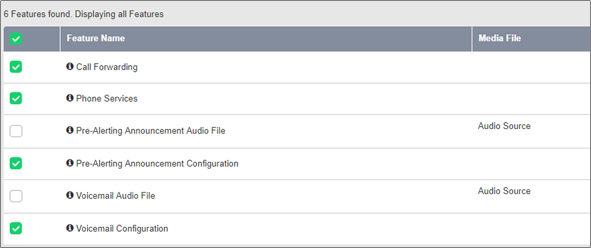
If you have other features to configure then carry on, if not select the Next button at the bottom of the page to complete the job.
This allows the Company Administrator or Group Administrator to manage the Site Features, Site Profile, Devices and view the Site Dashboard.
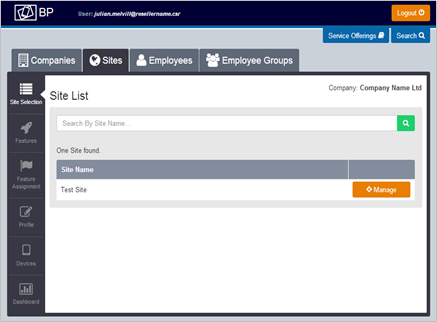
When you select the Sites tab you will be presented with a left-hand side bar, which provides administrative functions for that Site, as per the screenshot:
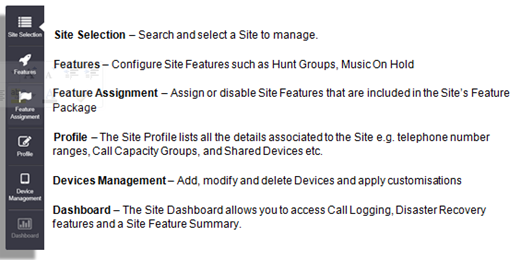
Select this tab to search, select and manage Sites:

You can search by Site name or simply hit the search button to return a list of all Sites.
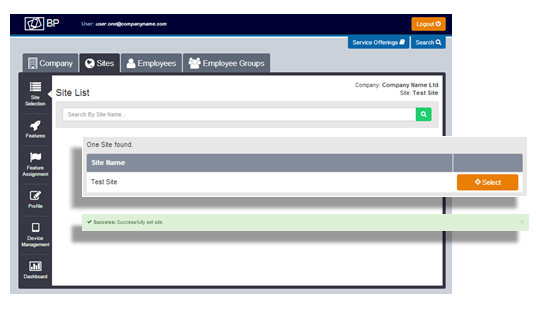
Features
Select this tab to configure Site features:

As a Company or Group Administrator, you can configure the features for a Site. Company Administrators can configure features for any Site within an entire Company. Group Administrators can only configure features for the individual Sites for which they have been granted administrative privileges. Site features are listed under the following categories and can be displayed as a List or a Grid:
- Call Groups – (e.g. Auto Attendants, Call Centres, and Hunt Groups).
- Contacts – (e.g. Company Contacts, Group Contacts, Phone Services).
- Management – (e.g. Call Capacity Management, Calling Plans, Group Calling Line ID).
- Portals & Bridges – (e.g. Call Director Portal, My Room Audio Conferencing Bridge and Voice Portal).
Click the Configure button next to the Site Feature that you wish to configure.
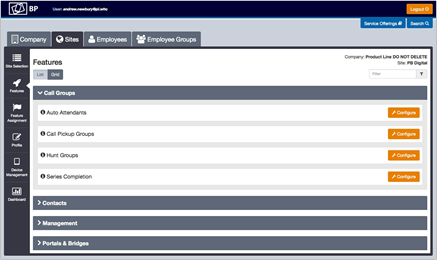
Feature Assignment

Select this tab to remove features from a Site:
As a Company Administrator or Group Administrator, you can use the Site Feature Assignment page to view the Site features that have been assigned to your Sites. You can also change these assignments, making features available or unavailable to individual Sites as required.
The changes you make to the feature assignments for a given Site apply to all Employees who use the service at that Site. For example, if you enable a specific feature, Employees at the Site can use it. If you disable a specific feature, it is not available for use by any Employees at the Site. Similarly, only features that are currently enabled can be configured using the Employee Feature Settings page. When you disable a feature, all corresponding configuration capabilities are also disabled. You can change a Site’s feature assignments at any time.
If you are a Company Administrator, you can view and edit feature assignments for any of your Company’s Sites. If you are a Group Administrator, you can only view and edit feature assignments if you have been granted administrative privileges for a Group that is being used to represent one of your Company’s Sites.
To assign or remove features, or to permit or deny a Group Administrator the right to make changes, select or clear the check boxes in the “Allow Admin Privileges” list:
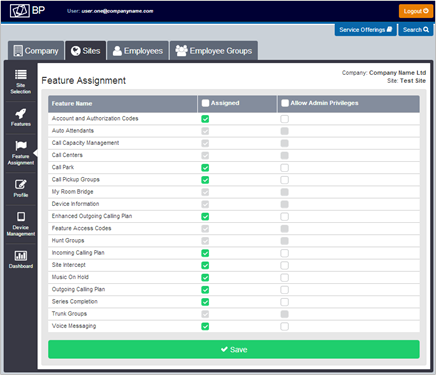
Select this tab to see a profile of the Site:

The Site Profile is informational and consists of the following:
- Site details (e.g. Number of Users, address and contact details).
- DN Ranges (telephone number/s associated to the Site).
- Call Capacity Groups
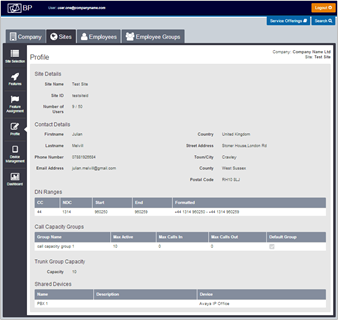
Select this tab to manage device configuration.

Review the next section for guidance on how to manage devices on a site.
This section is has already been explained in the dashboards section of this guide, above.

Device Management (Centrex only)
Select this tab to manage devices and profiles:

Please note, SIPT PBX’s cannot be edited here, and the display is informational only.
The Device Management feature allows you to create, modify, customise, and delete the devices (IP phones and/or ATA’s) that are used within a given Site. As an administrator, you can also see a list all of the devices that are currently in use within a Site, or search for specific devices by device name, device type, or available ports.
Devices are listed as:
- Device Types – type of devices associated to the Site, i.e. Polycom VVX 301
- Devices – individual devices under the Site, typically assigned to a User
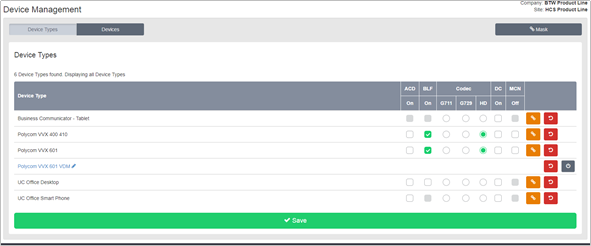
Device Types –Basic Customisation
The Device Types tab allows you to view, manage and apply customisations to all devices of a particular type (manufacturer and model) that are provisioned under the Site. For all supported devices then you will have access to some basic customisation, whereas for devices we sell, you may have access to advanced customisation using our Visual Device Manager (VDM), explained later on.

Only the customisations and their options that are available to the Device Type are displayed. Customisations that are not applicable are greyed out. Likewise for VDM devices and advanced customisation, no options will be displayed here, but instead the device type will be blue and available as a hyperlink, see later sections for instructions on this type of customisation
In order to customise all devices under the Site of certain types you simply choose from the customisation options, click Save and arrange to reboot the devices. The following table explains the available options:
|
Customisation |
Option |
Purpose |
|
ACD |
|
To apply Call Centre Agent ACD State soft keys to the device that allow Call Centre Agents to Sign In/Out of Call Centres that they are assigned to and set their ACD state e.g. Available, Wrap-Up, and Unavailable. |
|
ACD |
On (tick check box) |
This applies a configuration that will enable additional soft keys on the device for the Call Centre Agent to set their Call Centre ACD state. |
|
ACD |
Off (default) |
This applies a configuration that does not include the additional ACD soft keys for Users that are not a Call Centre Agent or who do not wish to use this functionality. |
|
BLF |
|
To apply Busy Lamp Field feature integration with devices. When this option is enabled the SIP transport is changed from UDP to TCP to ensure that the complete and larger BLF signalling is communicated successfully. You are advised to contact your Network Administrator before making any changes to this customisation. |
|
BLF |
On (tick check box) |
This applies Busy Lamp Field feature integration with the device and changes the signalling transport. |
|
BLF |
Off (default) |
Leave this option off or set to off when Busy Lamp Field integration is not required. |
|
Codec |
|
To apply a particular voice codec to reduce bandwidth consumption. Leave blank or click reset to use the default (applies G722 preference). You are advised to contact your Network Administrator before making any changes to this customisation. |
|
Codec |
G711 |
This applies a G711 codec preference. |
|
Codec |
G729 |
This applies only the G729 codec to ensure that a lower bandwidth is consumed at the cost of voice quality. |
|
Codec |
G722 |
This applies the G722 HD Voice codec which is set by default. It consumes the same bandwidth as G711 and can offer a more realistic voice quality. |
|
DC |
|
This applies a configuration to the device that allows it to operate and communicate with the platform over a private Direct Connection deployment e.g. a MPLS deployment that privately connects with the platform rather than via an Internet breakout point. You are advised to contact your Network Administrator before making any changes to this customisation. |
|
DC |
Off |
This applies a standard deployment option when the device communicates with the platform via normal access methods over the Internet and not a Direct Connect deployment. Setting this to Off for a Device Type that is DC enabled by default overrides the default and applies a configuration that is designed for communication over the Internet rather than the private access method. |
|
DC |
On |
This applies a configuration to the device that is designed for deployments where the device will operate over a private Direct Connection deployment. |
|
MCN |
|
To disable Missed Call Notifications on the device. |
|
MCN |
Off (tick check box) |
This disables Missed Call Notifications on the device. |
|
MCN |
On (default) |
Leave the check box unticked for Missed Call Notifications to be enabled – the default behaviour. |
Device Management also provides the option to create a configuration mask for customisations and apply this mask to multiple Device Types. This speeds up the application of the same customisations to multiple Device Types. Administrators select the mask options from the expandable Mask menu and then click the mask icon for each Device Type to apply the configuration.


In order for the devices to take on their new configuration, you will need to reboot all of the device types using the reboot button:

Selecting this button will instruct the phones to reboot, but please note, any device that is Unregistered will not be rebooted. When a device type reboot is initiated, the reboot icon that is normally displayed on the screen is replaced by a Reboot Status link until the reboot job is cleared, as per screenshot below.

When you click on the Reboot Status link, you are presented with a modal screen showing the date and time that the reboot was launched along with a list of device instances (at the time of reboot) of the specified type for the site, as per screenshot below. Manually refreshing the page will provide updates.
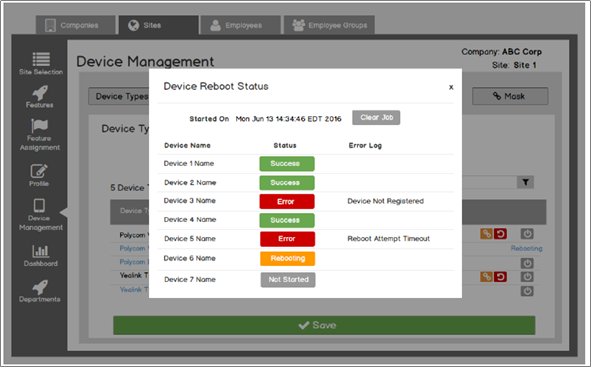
The following options may be seen:
Success - Device has been rebooted successfully
Error - There was an error while trying to reboot the device:
- Device not registered
- Reboot attempt timeout
- Internal Server Error
Pending - Reboot command has been sent to the device
Not Stared - Device has not been rebooted yet
Once the job has completed a refresh of the page will bring up the reboot button, providing all devices were successful. If they were not, you should select the Clear Job button to make the reboot button appear again for future use.
If the administrator has made lots of changes in error or simply wants to start again, then they can select the Reset option which will restore

- ACD - Default is Off
- BLF – Busy Lamp Field - Default is Off
- Codecs - Default is G722, G711A, G729
- DC - Default is Off
- MCN - Default is On
Once selected you will need to arrange to reboot the devices in order for the phones to restore themselves, using the procedure outlined above. Resetting a Device Type would default the following settings
Device Types- Advanced Customisation
If the device is using a VDM device type, capable of having advanced customisation, then the Device name will have the term VDM at the end of the name, will appear as a hyperlink and the basic configuration options will not appear on this front page.

Simply click on the hyperlink and it will open up the following screen.
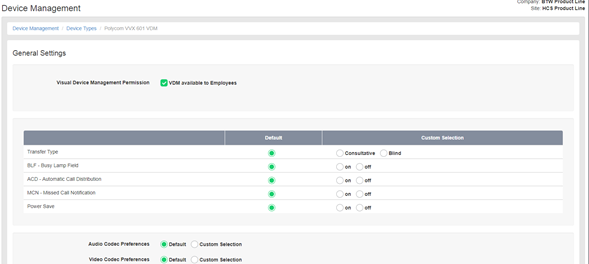
Company/Group Administrators can prevent Employees from using the Configure keys against VDM enabled devices. This will prevent these administration types from undertaking the following activity:
- Editing Line Keys
- Editing Soft Keys
- Editing Ringer Options
Restriction is done per Device Type per Site, individual Devices cannot be restricted. The following restriction option is then available:
- VDM available to Employees - Restrict End Users from accessing the VDM functionality by checking the available button.

Click on Save and they you will be presented with the following message
You can then customise all devices under the Site of certain types, similar to the options available in the Basic Customisation section, but with the following additions:
- Transfer Type
- Power Save
- Video Codecs
Again simply choose from the customisation options, click Save and arrange to reboot the devices. The following table explains the available options:
|
Customisation |
Option |
Purpose |
|
Transfer Type |
|
|
|
Transfer Type |
Consultative (Default) |
If this enabled, then when the user selects the transfer button soft key during a call, once they have entered the number it will dial the party they are transferring to. The user can then consult with the party before handing over the call and putting the phone down. |
|
Transfer Type |
Blind |
If this enabled, then when the user selects the transfer button soft key during a call it will transfer the call straight through with no consultation. |
|
BLF |
|
To apply Busy Lamp Field feature integration with devices. When this option is enabled the SIP transport is changed from UDP to TCP to ensure that the complete and larger BLF signalling is communicated successfully. You are advised to contact your Network Administrator before making any changes to this customisation. |
|
BLF |
On (tick check box) |
This applies Busy Lamp Field feature integration with the device and changes the signalling transport. |
|
BLF |
Off (default) |
Leave this option off or set to off when Busy Lamp Field integration is not required. |
|
ACD |
|
To apply Call Centre Agent ACD State soft keys to the device that allow Call Centre Agents to Sign In/Out of Call Centres that they are assigned to and set their ACD state e.g. Available, Wrap-Up, and Unavailable. |
|
ACD |
On (tick check box) |
This applies a configuration that will enable additional soft keys on the device for the Call Centre Agent to set their Call Centre ACD state. |
|
ACD |
Off (default) |
This applies a configuration that does not include the additional ACD soft keys for Users that are not a Call Centre Agent or who do not wish to use this functionality. |
|
MCN |
|
To disable Missed Call Notifications on the device. |
|
MCN |
Off (tick check box) |
This disables Missed Call Notifications on the device. |
|
MCN |
On (default) |
Leave the check box unticked for Missed Call Notifications to be enabled – the default behaviour. |
|
Power Save |
|
This will allow an administrator to turn off the Power Save mode. |
|
Power Save |
On (default) |
With this option, if the phone becomes inactive, then they ever so slightly reduce the brightness of their screens in order to conserve energy. In addition to this policy, during the hours of 19.00 – 07.00, 7 days a week, the phones screens will further reduce their brightness, and will look like they have turned off. This is an additional energy saving policy but does not affect calls or features. Simply touching a button, or screen on touchscreen variants, picking up the handset or receiving a call will immediately bring the screen back to full brightness |
|
Power Save |
Off tick check box) |
This disables the power saving mode. |
|
Audio Codec |
|
To apply a particular voice codec to reduce bandwidth consumption. Leave blank or click reset to use the default (applies H264 preference). You are advised to contact your Network Administrator before making any changes to this customisation. |
|
Codec |
G711 |
This applies a G711 codec preference. |
|
Codec |
G729 |
This applies only the G729 codec to ensure that a lower bandwidth is consumed at the cost of voice quality. |
|
Codec |
G722 |
This applies the G722 HD Voice codec which is set by default. It consumes the same bandwidth as G711 and can offer a more realistic voice quality. |
|
Video Codec |
|
To apply a particular video codec to reduce bandwidth consumption. Leave blank or click reset to use the default (applies G722 preference). You are advised to contact your Network Administrator before making any changes to this customisation. |
|
Codec |
H264 |
This applies a H264 codec preference. |
|
Codec |
H263 |
This applies a H263 codec preference. |
In order for the devices to take on their new configuration, you will need to reboot all of the device types using the reboot button:

Selecting this button will instruct the phones to reboot, but please note, any device that is Unregistered will not be rebooted. When a device type reboot is initiated, the reboot icon that is normally displayed on the screen is replaced by a Reboot Status link until the reboot job is cleared, as per screenshot below.

When you click on the Reboot Status link, you are presented with a modal screen showing the date and time that the reboot was launched along with a list of device instances (at the time of reboot) of the specified type for the site, as per screenshot below. Manually refreshing the page will provide updates.
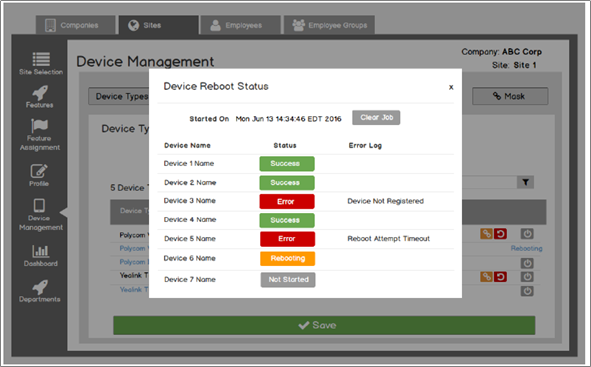
The following options may be seen:
Success - Device has been rebooted successfully
- Device not registered
- Reboot attempt timeout
- Internal Server Error
Error - There was an error while trying to reboot the device:
Pending - Reboot command has been sent to the device
Not Stared - Device has not been rebooted yet
Once the job has completed a refresh of the page will bring up the reboot button, providing all devices were successful. If they were not, you should select the Clear Job button to make the reboot button appear again for future use.
If the administrator has made lots of changes in error or simply wants to start again, then they can select the Reset option which will restore the configuration file back to their original working state.

Once selected you will need to arrange to reboot the devices in order for the phones to restore themselves, using the procedure outlined above. Resetting a Device Type would default the following settings:
- Transfer Type – Default is Consultative
- BLF – Busy Lamp Field - Default is Off
- ACD - Default is Off
- MCN - Default is On
- Power Save - Default is On
- Audio Codecs - Default is G722, G711A, G729
- Video Codecs - Default is H264, H263
The Devices tab allows you to search, create, modify and delete devices and view, manage and apply customisations to a subset of devices or individual devices that are provisioned under the Site. For all supported devices then you will have access to some basic customisation, whereas for devices we sell, you may have access to advanced customisation using our Visual Device Manager (VDM), explained further on.

Only the customisations and their options that are available to the Device Type are displayed. Customisations that are not applicable are greyed out. Likewise for VDM devices and advanced customisation, no options will be displayed here, but instead the device type will be blue and available as a hyperlink, see later sections for instructions on this type of customisation
In order to customise individual devices you simply locate the device and then choose from the available customisation options, as per above table, click Save and then arrange to reboot the devices. If you can’t find it then you can use the Search button to locate the device:

In order to customise a device under the Site, you simply choose from he customisation options, click Save and arrange to reboot the device. The following table explains the available options:
|
Customisation |
Option |
Purpose |
|
ACD |
|
To apply Call Centre Agent ACD State soft keys to the device that allow Call Centre Agents to Sign In/Out of Call Centres that they are assigned to and set their ACD state e.g. Available, Wrap-Up, and Unavailable. |
|
ACD |
On (tick check box) |
This applies a configuration that will enable additional soft keys on the device for the Call Centre Agent to set their Call Centre ACD state. |
|
ACD |
Off (default) |
This applies a configuration that does not include the additional ACD soft keys for Users that are not a Call Centre Agent or who do not wish to use this functionality. |
|
BLF |
|
To apply Busy Lamp Field feature integration with devices. When this option is enabled the SIP transport is changed from UDP to TCP to ensure that the complete and larger BLF signalling is communicated successfully. You are advised to contact your Network Administrator before making any changes to this customisation. |
|
BLF |
On (tick check box) |
This applies Busy Lamp Field feature integration with the device and changes the signalling transport. |
|
BLF |
Off (default) |
Leave this option off or set to off when Busy Lamp Field integration is not required. |
|
Codec |
|
To apply a particular voice codec to reduce bandwidth consumption. Leave blank or click reset to use the default (applies G722 preference). You are advised to contact your Network Administrator before making any changes to this customisation. |
|
Codec |
G711 |
This applies a G711 codec preference. |
|
Codec |
G729 |
This applies only the G729 codec to ensure that a lower bandwidth is consumed at the cost of voice quality. |
|
Codec |
G722 |
This applies the G722 HD Voice codec which is set by default. It consumes the same bandwidth as G711 and can offer a more realistic voice quality. |
|
DC |
|
This applies a configuration to the device that allows it to operate and communicate with the platform over a private Direct Connection deployment e.g. a MPLS deployment that privately connects with the platform rather than via an Internet breakout point. You are advised to contact your Network Administrator before making any changes to this customisation. |
|
DC |
Off |
This applies a standard deployment option when the device communicates with the platform via normal access methods over the Internet and not a Direct Connect deployment. Setting this to Off for a Device Type that is DC enabled by default overrides the default and applies a configuration that is designed for communication over the Internet rather than the private access method. |
|
DC |
On |
This applies a configuration to the device that is designed for deployments where the device will operate over a private Direct Connection deployment. |
|
MCN |
|
To disable Missed Call Notifications on the device. |
|
MCN |
Off (tick check box) |
This disables Missed Call Notifications on the device. |
|
MCN |
On (default) |
Leave the check box unticked for Missed Call Notifications to be enabled – the default behaviour. |
Device Management also provides the option to create a configuration mask for customisations and apply this mask to multiple Device Types. This speeds up the application of the same customisations to multiple Device Types. Administrators select the mask options from the expandable Mask menu and then click the mask icon for each Device Type to apply the configuration.

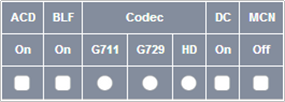
In order for the device to take on their new configuration, you will need to reboot the device using the reboot button:

Selecting this button will instruct the phone to reboot, but please note, any device that is Unregistered will not be rebooted. When a device type reboot is initiated, the reboot icon that is normally displayed on the screen is replaced by a Reboot Status link until the reboot job is cleared, as per screenshot below.

When you click on the Reboot Status link, you are presented with a modal screen showing the date and time that the reboot was launched along with the device instance as per screenshot below. Manually refreshing the page will provide updates.

The following options may be seen:
Error - There was an error while trying to reboot the device:
- Device not registered
- Reboot attempt timeout
- Internal Server Error
Pending - Reboot command has been sent to the device
Not Stared - Device has not been rebooted yet
Once the job has completed a refresh of the page will bring up the reboot button, providing all devices were successful. If they were not, you should select the Clear Job button to make the reboot button appear again for future use.
If the administrator has made lots of changes in error or simply wants to start again, then they can select the Reset option which will restore the configuration file back to its original working state.

Once selected you will need to arrange to reboot the device in order for the phones to restore themselves, using the procedure outlined above. Resetting a Device would default the following settings:
- ACD - Default is Off
- BLF – Busy Lamp Field - Default is Off
- Codecs - Default is G722, G711A, G729
- DC - Default is Off
- MCN - Default is On
Devices – Advanced Customisation
If the device is using a VDM device type, capable of having advanced customisation, then the Device name will have the term VDM at the end of the name, similar to the one below.

Simply click on a device which will open up the following three options:
- Device Profile – this provides an overview of the device along with its registration status.
- General Settings – this enables you to customise a device, similar to the options available in the Basic Customisation section, but with a few additions.
- Option Keys – this enables you to set-up speed dials and function keys, including a customer function.
Clicking on this option will open up the following screen displaying some basic information along with a Registered or Non Registered status.
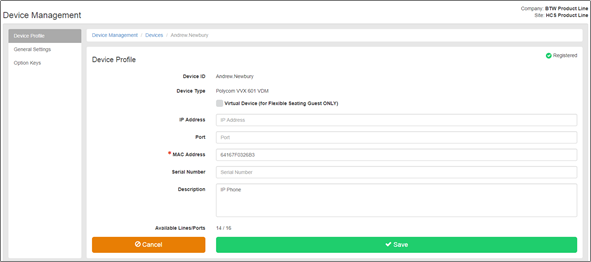
Clicking on this option will open up the following screen:
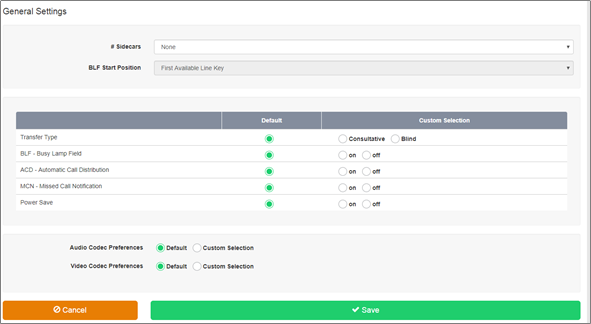
You can customise the settings for IP Phone Sidecars:
- # Sidecars – Select the type and quantity of sidecar attachments that the device will be using
- BLF Start Position – Select whether BLF keys will start on the phone first, using available line keys, or whether it will start on the sidecar first.

When you add a Sidecar a static image will also appear in the Business Portal, from page 4. You can then use the sidecar to also add Line and Speed Dial keys, explained further on. If you want to use the Sidecar just for speed dials, and are not using BLF, simply ignore the BLF Start Position parameter.
Click on Save and you will be presented with the following message.

If you have further changes to make then make these first. Otherwise, scroll to the bottom of the page and select the Reboot button. This will instruct the phone to power off and then back on, once it has powered on the Ringer will have changed.
Further down you can then customise a device, similar to the options available in the Basic Customisation section, but with the following additions:
- Transfer Type
- Power Save
- Video Codecs
Again simply choose from the customisation options, click Save and arrange to reboot the device.
The following table explains the available options:
|
Customisation |
Option |
Purpose |
|
Transfer Type |
|
|
|
Transfer Type |
Consultative (Default) |
If this enabled, then when the user selects the transfer button soft key during a call, once they have entered the number it will dial the party you are transferring to. The user can then consult with the party before handing over the call and putting the phone down. |
|
Transfer Type |
Blind |
If this enabled, then when the user selects the transfer button soft key during a call it will transfer the call straight through with no consultation. |
|
BLF |
|
To apply Busy Lamp Field feature integration with devices. When this option is enabled the SIP transport is changed from UDP to TCP to ensure that the complete and larger BLF signalling is communicated successfully. You are advised to contact your Network Administrator before making any changes to this customisation. |
|
BLF |
On (tick check box) |
This applies Busy Lamp Field feature integration with the device and changes the signalling transport. |
|
BLF |
Off (default) |
Leave this option off or set to off when Busy Lamp Field integration is not required. |
|
ACD |
|
To apply Call Centre Agent ACD State soft keys to the device that allow Call Centre Agents to Sign In/Out of Call Centres that they are assigned to and set their ACD state e.g. Available, Wrap-Up, and Unavailable. |
|
ACD |
On (tick check box) |
This applies a configuration that will enable additional soft keys on the device for the Call Centre Agent to set their Call Centre ACD state. |
|
ACD |
Off (default) |
This applies a configuration that does not include the additional ACD soft keys for Users that are not a Call Centre Agent or who do not wish to use this functionality. |
|
MCN |
|
To disable Missed Call Notifications on the device. |
|
MCN |
Off (tick check box) |
This disables Missed Call Notifications on the device. |
|
MCN |
On (default) |
Leave the check box unticked for Missed Call Notifications to be enabled – the default behaviour. |
|
Power Save |
|
This will allow an administrator to turn off the Power Save mode. |
|
Power Save |
On (default) |
With this option, if the phone becomes inactive, then they ever so slightly reduce the brightness of their screens in order to conserve energy. In addition to this policy, during the hours of 19.00 – 07.00, 7 days a week, the phones screens will further reduce their brightness, and will look like they have turned off. This is an additional energy saving policy but does not affect calls or features. Simply touching a button, or screen on touchscreen variants, picking up the handset or receiving a call will immediately bring the screen back to full brightness |
|
Power Save |
Off tick check box) |
This disables the power saving mode. |
|
Audio Codec |
|
To apply a particular voice codec to reduce bandwidth consumption. Leave blank or click reset to use the default (applies G722 preference). You are advised to contact your Network Administrator before making any changes to this customisation. |
|
Codec |
G711 |
This applies a G711 codec preference. |
|
Codec |
G729 |
This applies only the G729 codec to ensure that a lower bandwidth is consumed at the cost of voice quality. |
|
Codec |
G722 |
This applies the G722 HD Voice codec which is set by default. It consumes the same bandwidth as G711 and can offer a more realistic voice quality. |
|
Video Codec |
|
To apply a particular video codec to reduce bandwidth consumption. Leave blank or click reset to use the default (applies H264 preference). You are advised to contact your Network Administrator before making any changes to this customisation. |
|
Codec |
H264 (Default) |
This applies a H264 codec preference. |
|
Codec |
H263 |
This applies a H263 codec preference. |
Clicking on this option will open up the following screen:
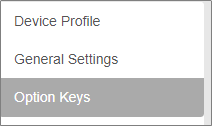
Once you click on this button you will be presented with the page below and the following tabs will be available:
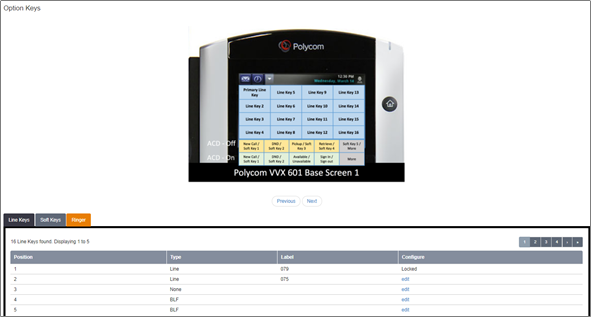
- Line Keys
- If you are accessing the device tab from the Employees tab then a VDM device type will have a high resolution image of the device, similar to the below.
- Soft Keys
- Ringer

The Configure button will then be available to use.

Line Keys
A Line key is a soft/hard key that the phone manufacturer has determined can be used for the purpose of assigning a phone number to. The number of available keys depends on the manufacturer and the model number. When you click the customise button it will present you with a static image displaying the number of available keys. Most phones have up to 3 different pages of customisations, and if you are using a Sidecar there will be additional pages, so please ensure you use the Next button to see the options available.
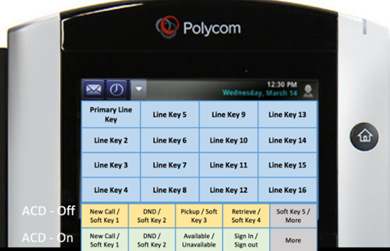
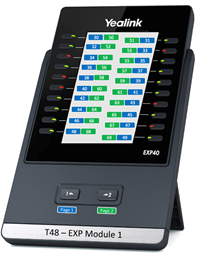
When you click on the Edit button against a key option, whether in use or spare, the following will be available in the drop down:

- None – This simply inserts a blank into that key and prevents any other key using it. This is important if you are using BLF, and do not want a BLF to take this key. Please note this is currently only available on Polycom Devices.
- Reset to Default – This will simply reset the key back to its original default setting, as displayed on the static phone images. Once you do this it will update the configuration file but you will then need to reboot the phone.
- Line - This is either your Primary Number, an Additional Line or a Shared Call Appearance Line. Please see below for further instructions.
- Speed Dial – This allows you to add a phone number with a name and display this on your phones home screen. Please see below for further instructions.
Please note, all un-used keys will have a Type set as BLF, this is just to allow the BLFs to automatically update if you use this feature. If you don’t then you simply use these keys as they are spares.
If you have had an Additional Line or Shared Call Appearance created for you by your Administrator, then this new line will automatically appear in the next available spare Line Key. If you are not happy with this position then you can move it.
Locate the Line Key as per the example below and select edit.

From the dialogue box, change to None to remove the key from this position.
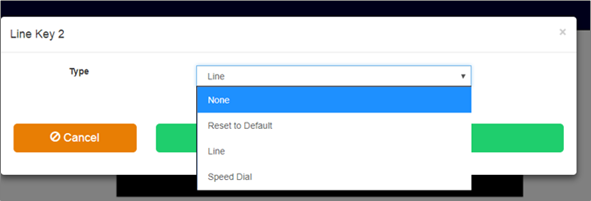
Then locate the key slot that you want to place the Line key in and select edit. From here, select Line and then it will automatically assign the line key to this slot.

Click on Save and they you will be presented with the following message.

If you have further changes to make then make these first. Otherwise scroll to the bottom of the page and select the Reboot button. This will instruct the phone to power off and then back on, once it has powered on the Line Key will appear in the new position.

Please note the image displayed in the portal is static so will not change, only the table will update to show the key is being used. To re-order any keys, you first need to remove then and then reassign them to the slot you require.
Assign a Speed Dial Key
To assign a Speed Dial, select edit against a key that is spare, remembering that a spare key will show BLF, but the label will be blank.

Select Speed Dial from the Type drop down.
Insert a name in the Label box, which will display on the phone, typically this will be the name of the person whom the number belongs to. Enter the telephone number into the Number parameter, ensuring you enter this correctly as there is no validation on the number entered here.
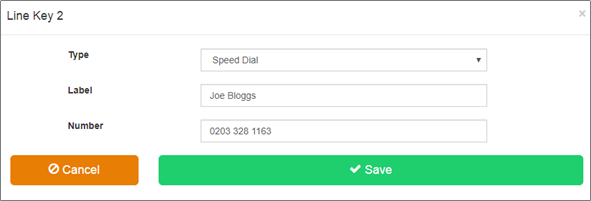
Click on Save and you will be presented with the following message.

If you have further changes to make then make these first. Otherwise scroll to the bottom of the page and select the Reboot button. This will instruct the phone to power off and then back on, once it has powered on the Speed Dial will appear on the phone.

Please note the image displayed in the portal is static so will not change, only the table will update to show the key is being used. To re-order any keys, you first need to remove then and then reassign them to the slot you require.
Assign a BLF Key
You can’t assign a BLF key from the Configure option, BLF numbers are set and displayed in the order as defined within the Features setting page. BLF numbers will automatically take the next available line key.

Insert a name in the Label box, which will display on the phone, typically this will be the name of the person whom the number belongs to. Enter the telephone number into the Number parameter, ensuring you enter this correctly as there is no validation on the number entered here.
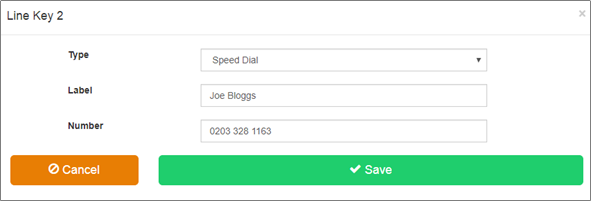
Click on Save and you will be presented with the following message.

If you have further changes to make then make these first. Otherwise scroll do the bottom of the page and select the Reboot button. This will instruct the phone to power off and then back on, once it has powered on the Speed Dial will appear on the phone.

Please note the image displayed in the portal is static so will not change, only the table will update to show the key is being used.
Assign a BLF Key

You can’t assign a BLF key from the Configure option, BLF numbers are set and displayed in the order as defined within the Features setting page. BLF numbers will automatically take the next available line key.
Soft Keys
A Soft key is a soft/hard key that the phone manufacturer has determined can be used for the purpose of assigning functions to. The number of keys available depends on the manufacturer and the model number. When you click the customise button it will present you with a static image displaying the number of available keys. Most phones have up to 3 different pages of customisations so please ensure you use the Next button to see the options available.
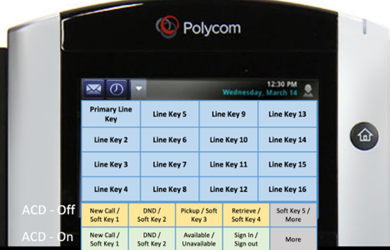
When you click on the Edit button against a key option, whether in use or spare, the following will be available in the drop down:

- None – This simply removes a function key and frees it for further use.
- Reset to Default – This will simply reset the key back to its original default setting, as displayed on the static phone image. Once you do this it will update the configuration file but you will then need to reboot the phone.
- Function - This allows you to set a key to operate a specific function from the available list that the platform provides, including setting a Custom Function. For example if you use Office UC Smartphone you may regularly move calls between the mobile and IP phone handsets so here you can assign the Pull function (*11) to a key.
- Speed Dial – This allows the user to add a phone number with a name and display this on their phones home screen. Please see below for further instructions.
Assign a Function Key
To assign a Function key, select edit against a key that is spare.

Select Function from the Type drop down.

Select one of the options from the Function drop down.
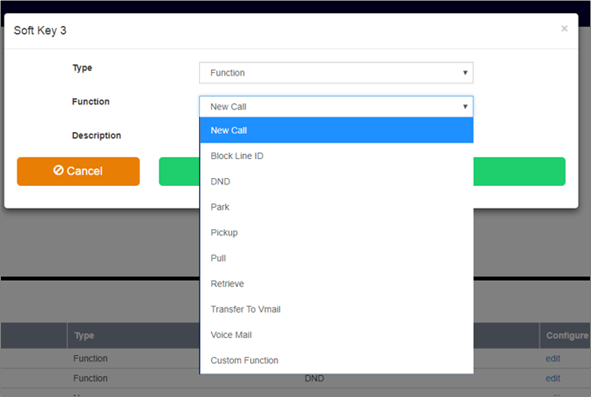
Once you select a function key it will also provide a brief description of the keys operation.
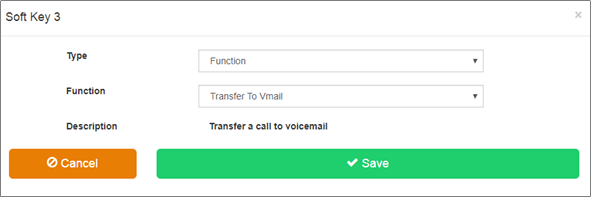
To create a Custom Function select this option which will open up a more advanced screen
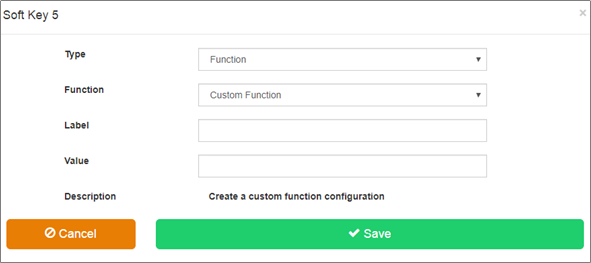
Custom functions require you to input a configuration based on macros, which may be different for each manufacturer. The most common uses for a custom function is:
- Night Key – Allows you to program a key that once pushed will dial the Voice Portal, input the pin and then set something like Call Forwarding Always on.
- Conference Bridge – Allows you to program a key that once pushed will dial the conference call and input the pin number for you.
Provide a name in the Label box, which will then appear on the phone and then enter either of these into the values box:
- Night Key = [Voice Portal Number]$Tinvite$$Cwc$*$Tdtmf$[Ext Number of Virtual User]$Tdtmf$[Pin Number with #]$Tdtmf$$Cp1$3$Tdtmf$ then [User Follows Prompts]
- Example as follows - 2281$Tinvite$$Cwc$*$Tdtmf$222x$Tdtmf$051x#$Tdtmf$$Cp1$3$Tdtmf$ then [User Follows Prompts]
- Conference Bridge = [Conference Number]$Tinvite$$Cwc$$Cpause1$[Conference Pin# ]$Tdtmf$
- Example as follows - 0870850652x$Tinvite$$Cwc$$Cpause1$56207xxx#$Tdtmf$
For all other custom functions please refer to the manufacturer’s user guides from their websites.
Click on Save and they you will be presented with the following message.

If you have further changes to make then make these first. Otherwise scroll to the bottom of the page and select the Reboot button. This will instruct the phone to power off and then back on, once it has powered on the Speed Dial will appear on the phone.

Please note the image displayed in the portal is static, so will not change, only the table will update to show the key is being used.
Assign a Speed Dial Key
To assign a Speed Dial, select edit against a key that is spare.

Select Speed Dial from the Type drop down.

Insert a name in the Label box, which will display on the phone, typically this will be the name of the person whom the number belongs to. Enter the telephone number into the Number parameter, ensuring you enter this correctly as there is no validation on the number entered here.
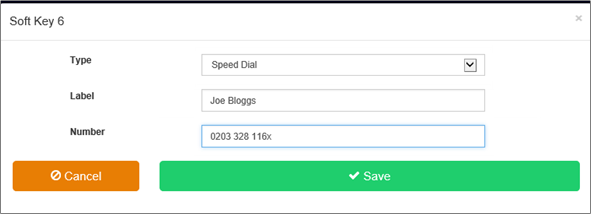
Click on Save and they you will be presented with the following message.

If you have further changes to make, then make these first. Otherwise, scroll to the bottom of the page and select the Reboot button. This will instruct the phone to power off and then back on, once it has powered on the Speed Dial will appear on the phone.

Please note the image displayed in the portal is static, so will not change, only the table will update to show the key is being used. To re-order any keys, you first need to remove then and then reassign them to the slot you prefer.
The enables you to change the default audible ring tone used by the phone. If you would like to hear samples of these before you set this, then you need to do this on the phone as per the instructions below:
Polycom Devices
- Select the Home Key
- Select the Settings Key
- Select 1 Basic
- Select 5 Ring Type
- Select 1 Default
- Place a tick in any of the boxes and select the Play button to hear the ring tone.
Yealink Devices
The following is for the T42 device:
- Select Menu
- Select Settings
- Select Basic Settings
- Select Sound
- Select Ring Tones
- Select Common
- Press any of the options to hear the ring tone.
The following is for the T46/48 device:
- Select Menu
- Select Basic
- Select Sound
- Select Ring Tones
- Select Common
- Press any of the options to hear the ring tone.
Although you can set the ringer on the phones it will not add it to the configuration file and any future updates will remove it. To set correctly you must do this in the Business Portal by selecting the Ringer tab.

This will then bring up a series of options, select the one you like based on what you found on the phone.
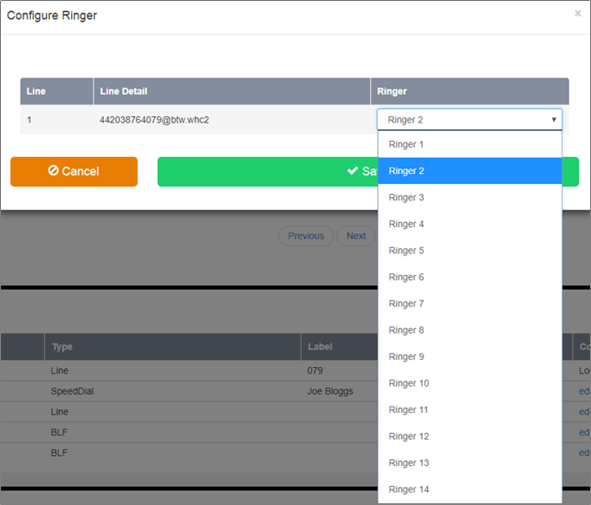
Click on Save and you will be presented with the following message.
If you have further changes to make then make these first. Otherwise, scroll do the bottom of the page and select the Reboot button. This will instruct the phone to power off and then back on, once it has powered on the Ringer will have changed.
If you creating users and ordering them a phone then this activity will need to be carried out from the Business Zone order journey, please refer to the WHC L2C Ordering User Guide, available on the Document Centre.
If you adding a device, using a device in your possession, of if you have removed a device and want to rebuild/assign then follow the procedure below:
To add a new device click the +Add button underneath the Search button:

Then follow these steps:
Click New - The New Device page is displayed
Fill in the fields to configure the new device
New Device Fields:
- MAC Address - The MAC address of the device
- Device Type - The type (make and model) of device
- Device ID – A unique identifier for the device
Click Save
Please note, if you adding a device, try to select a device profile with VDM on the end of the name. This uses our new profile and will open up Advanced Customisation for administrators and users. In the future we will be looking to remove non VDM device profiles so this will prevent future changes.
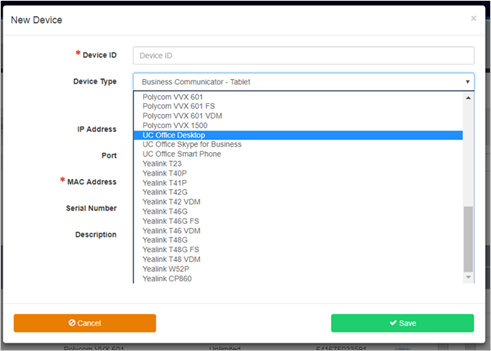
Converting a Device to a VDM Profile
The following device profiles can be converted to a VDM device profile, opening up Advanced Customisation:
- Polycom VVX 301
- Polycom VVX 411
- Polycom VVX 601
- Yealink T42G
- Yealink T46G
- Yealink T48G
To convert one of these devices you will need to follow the procedure set out below:
- Log into Business Portal as a Reseller, Company or Group Administrator.
- Navigate to Employees, locate the User and under Service Settings, change the device to none, followed by Save.
- Navigate to Sites, select Device Management, Click Devices tab, delete the standard device profile for that user (this removes the device and MAC address from site).
- In the same area, build a new Device using one of the VDM profiles.
- Navigate back to Employees, locate the User and under Service Settings, change the device to the new VDM one, followed by Save.
- Reboot the phone, manually, and when the device comes back it will have the new VDM device profile.
This should only take a couple of minutes per user.
If you have ordered Spare Devices against the Site in Business Zone, then IP Phones will be pre-built against the Site, allowing you to allocate to a user once you are ready. A spare device can be located as it will be named as the MAC address of the device, and listed with the word ‘none’ in the Users column, as per the example below.
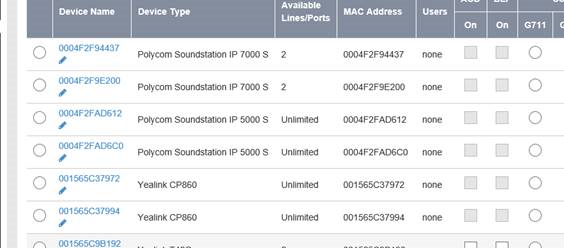
Adding & Managing Groups (optional)
As a Company Administrator, you can use the Business Portal to create a hierarchy of Groups for organising your Company’s Employee accounts. Each Group you create can act as a container for other Groups, for specific sets of Employee accounts, or both. You can build a multi-level Group hierarchy by creating one or more “top-level” Groups, and then by adding “sub-Groups” within this top-level Group. Once you have created a Group hierarchy, you can assign Employees to specific Groups or create additional Groups as required.
You can use Groups to organise your Company’s user accounts in any meaningful way. For example, you can use Groups to reflect your Company’s real-world organisational or functional structure:
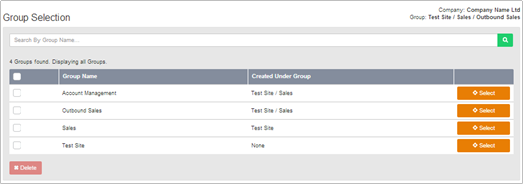
When you start to manage your Company’s hierarchy of Groups and user accounts, you will notice that some Group/s have already been created. These Group/s represent your Company and its geographic location/s, specifically, the Company Site/s at which the service can be activated. These Groups are created by the CP during the Business Zone build process and appear as top-level Groups.
As a Company Administrator, you cannot create Company Site-specific Groups. You can view the Site-specific Groups that your CP has created, modify their properties, and assign administrators to them, just like you can with any Groups you create. Unlike the Groups you create, however, when you assign a Group Administrator to a Group that represents a Site, you give this User the ability to configure service features that apply to the Site as a whole.
When you select the Employee Groups tab you will be presented with a left-hand side bar, which provides administrative functions for that Group, as per the sample image screenshot below:
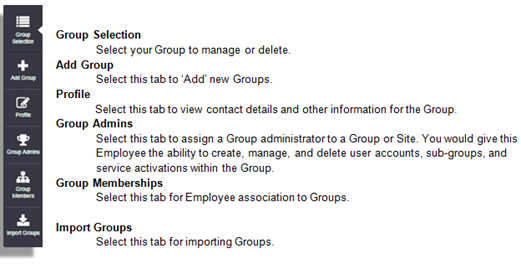
Select this tab to manage or delete Groups:

You can search by Site name or Group name by simply hitting the search button to return a list of all Groups or by entering a name before searching. Please note Sites are classed as Groups and are automatically built as standard.
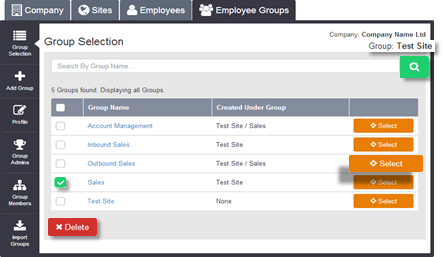
Select this tab to add new Groups:

If you are logged in as a Company Administrator, this page lists all the Groups that currently exist within the Company. If you are logged in as a Group Administrator, this page lists the Groups for which you have been assigned administrative privileges.
You can use the Business Portal to add Users to Groups that represent the logical organisation of the Company at any time. You can then add the User to any existing Group or remove specific Group Memberships as required. If you are a Group Administrator, you can only manage Group Memberships on behalf of Users who are members of the Groups for which you have been assigned administrative privileges.

To add a Group select the Create Under Group and complete the required fields.
Select this tab to see or amend a Group profile:

You are able to view or amend the following:
- Created Under Group - The Group that the current Group was created under. If it is a top-level Group, this value is “none”. If it is a sub-level Group, this value is the name of the Group or Groups above the current Group in the hierarchy, for example, “Sales“ or “Sales/Sales West”.
- Group Name - The name of the Group. Once you create a Group or sub-Group, you cannot change its name.
- (Optional) Contact First Name
- (Optional) Contact Last Name
- (Optional) Contact Email Address
- (Optional) Contact Phone Number
- (Optional) Address

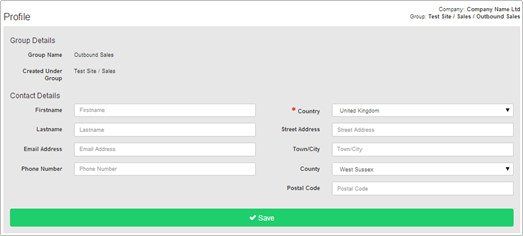
Select this tab to assign a Group Administrator to a Group:

When you assign a Group Administrator to a Group, you give this Employee the ability to manage user accounts and sub-groups within the Group. When you assign a Group Administrator to a Group that represents one of your Company’s Sites, the Group Administrator also gains the ability to configure the service features that apply to the entire Site.
When you assign a Group Administrator to a Group, the administrative capabilities extend to all sub-Groups contained within the Group. These privileges do not extend upward within the Group hierarchy.
You cannot assign Group administration privileges to users who have Employee or Company administrator accounts. Employee accounts have no administrative capabilities; Company Administrators automatically have administrative privileges for all Groups within the Company. You therefore need to change the employees’ administration layer to ‘Group Admin’ under the ‘Profile’ tab of the User.
If you are a Company Administrator, you can use the Business Portal to assign a Group Administrator to any Group or sub-Group. If you are a Group Administrator, you can use the Business Portal to assign Group Administrators to any of the Groups you manage.
Assign an Administrator to a Group
Set the Group that you want to assign administrators to, as described in “Group Selection” side tab then follow these simple steps:
Select the “Group Admins” side tab and “Search”.
Select the desired Administrator/s.

You can limit the search by selecting one of the following:
- Administrators not of this Group
- Administrators of this Group
- All Group administrators

Select the check box beside the name of each Employee to whom you want to grant administrative privileges for the Group or clear the check box beside the name of each employee from whom you want to remove administrative privileges for the group.

Click “Save” to save your changes

A message is displayed at the top of the page to indicate that the Group’s administrator settings have been updated
Select this tab to assign a Group administrator to a Group:

Once you create a Group, you can select it and assign Employees or “members” to it to continue building your organisational hierarchy.
If you are a Company Administrator, you can assign any Employee to any Group. Similarly, you can remove Employees from specific Groups or move Employees between Groups as required. If you are a Group Administrator, you can assign Employees to any Group you have created or for which you have been assigned administrative privileges. Similarly, you can remove Employees from any of the Groups you manage.
Set the Group that you want to assign administrators to, as described in “Group Selection” side Tab and select “Search”. If you are logged in as a Company Administrator, this page lists all the Groups that currently exist within the Company. If you are logged in as a Group Administrator, this page lists the Groups for which you have been assigned administrative privileges.
Select the check box beside the username of each Employee that you want to add to the Group or clear the check box beside the username of each Employee that you want to remove from the Group then select Save.


A message is displayed at the top of the page to indicate that the Group’s administrator settings have been updated.

Import Group
Select this tab to import groups rather than creating them on the portal:

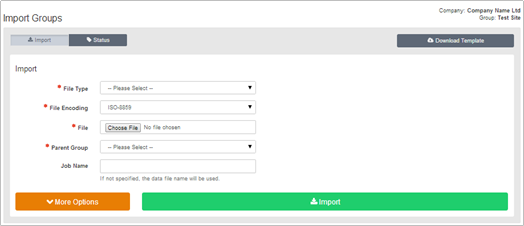
Preparation and Importing Groups
The following sections describe tasks you must perform using applications other than the Business Portal. It is recommended that you consult the documentation provided with these applications as you perform these tasks.
- Click the “Download Template” link. If you are filling in a Group template, you must specify a value in the Name column for each Group you intend to import e.g. Sales Group.

Select the type of file from which you want to import Groups.

You can choose Microsoft Outlook (.csv), Custom Template (.csv), or XML Document (.xml).
- The file type you choose must correspond to the file that contains the Group information you want to import. Custom Template (.csv) is recommended for Group Import files created using Microsoft Excel.
- Browse and Select the file you want to import.

- Select the “Parent Group” you need the Group imported under.

- Type a name for the import job in the field provided; this name will be used to identify the job so that you can track its progress.
- More Options:
- Schedule – Start now or select a future date and time.
- Method:
- Add New Groups - Adds all new Groups specified in the import file; does not change the information for Groups who already exist within the selected target Group.
- Update Current Groups - Overwrites the information for existing Groups with the information specified in the import file; does not add new Groups specified in the import file.
- Priority – Low, Medium, High
- Mode – “Run In Test Mode” is recommended for first time users to test the Job before submitting.
- Click Import.

- You can check the status of any ongoing or completed import jobs using the Check Status page.
The Employee will be able to log in and manage their own features and passwords etc. However an Administrator can also do this as well as administer the Employee’s Devices, change their license settings or add more Employees (Employees can’t administer their own devices.)
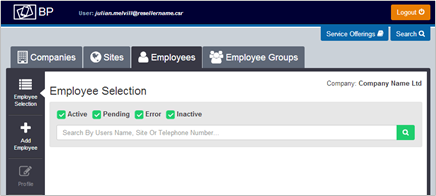
When you select the Employees tab you will be presented with a left-hand side bar, which provides administrative functions for that User, as per the sample image screenshot below.
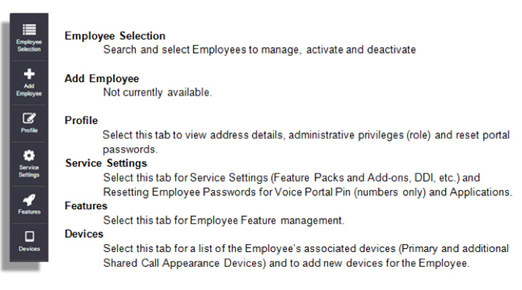
Employee Selection
Select this tab to search, select and manage Employees. This tab can also be selected to add new Employees where this functionality has been enabled by the CP Administrator.

You can search by Employee name or simply hit the search button to return a list of all Employees which will then allow you to perform a number of chances as detailed after the Add Employee selection below

Add Employee
Select this tab to Add a new Employee (User) but beware this functionality is turned off by default and is only available to use if turned on by the CP in the Business Zone Ordering portal. You will know if this is off as when you click Add Employee, the Save and Activate buttons will be greyed out.

Add Employee allows the creation and activation of Employees. You can use the Service Offering tab for information to determine which Feature Package and Add-Ons (if required) that you want to assign to each Employee within your Company. To View the ‘Service Offerings Menu’ in the Business Portal refer to the section in this document called Service Offerings Tab for further information.
For each Employee an ‘Employee Account’ is created, or ‘user object’, that specifies personal information including:
- Employee’s username
- Employee’s password
- First and Last Name
- E-mail address – It is recommended that an E-mail address for the employee is included as the welcome Email that contains the User details will be sent to this address.
- Types of Admin privileges that can be applied to the User:
Company Administrator:
- Control over entire Customer organization.
- Ability to create, modify and delete users within the Customer organization (were turned on by the CP Administrator)
- Ability to subscribe for services and activate end users (were turned on by the CP Administrator)
- Ability to manage Site features
Group:
- Control over a Group or Site within the Customer.
- Ability to create, modify, and delete users within that Group (were turned on by the CP Administrator)
- Ability to activate users for service within that Group (were turned on by the CP Administrator)
- Ability to manage Site features
End User:
- Control only over own account and features
- Optional - Location information can be specified for each individual if available, but is NOT used for emergency services location information, the Site location information is used.
In the Business Portal you can use the Employee tab as your starting point for creating new users to the ‘Add Employee’ button can be used from the Company Dashboard. The following Administrators can perform the below listed tasks where this function has been turned on by the CP Administrator:
- Company Administrator - can activate Employees in their Company.
- Group Administrator - can only activate Employees who are members of Groups for which they have been assigned administrative privileges.
To add an Employee account/new User in the Business Portal, navigate the top tabs to the Employees tab:

Click ‘+ Add Employee’ on the left hand sidebar and enter the required information about the Employee using the fields provided.

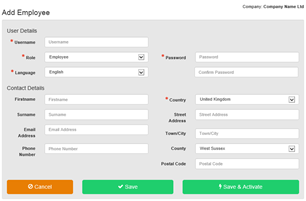
Or click on the Add Employee button from the Company Dashboard:

Enter a Username for the User. This will be the Employee’s log in name for the Business Portal. Please note that usernames are case sensitive.
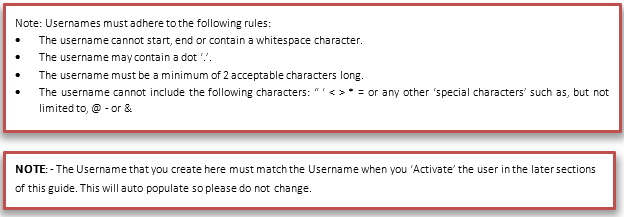
Select the Employee “Role” from the drop down list. This sets the level of access to the BP for the Employee:
- Company Administrator
- Group Administrator
- Employee
Enter and confirm a Password of at least 8 characters in length and contains:
- One uppercase letter
- One lowercase letter
- One digit
- One symbol
Enter a valid email address:
- This field is not mandatory, but should be completed to receive Welcome emails.
Enter the rest of the details as required for the Employee.
- First Name - The Employee’s first name.
- Surname - The Employee’s surname.
- Phone Number - The Employee’s telephone number (optional and not needed)
- Address Details Fields - The Employee’s location and contact information (optional and not needed).
Location information can be specified for each individual if available, but is NOT used for emergency services location information.
- Click ‘Save & Activate’.

- Select the Site from the drop down list.


In the Employee’s Settings section, complete the details for the Employee as required.
- The ‘Username’ is automatically populated with the ‘Username’ that you entered in the previous step and should not be changed.
Enter a “First and Last Name” for the Employee.
- First Name — used for the display name on the user’s phone and other devices. This automatically populated with the ‘Name’ that you entered in the previous step and should not be changed.
- Surname — used for the display name on the user’s phones and other devices. This automatically populated with the ‘Surname’ that you entered in the previous step and should not be changed

Enter a “Calling Line ID First Name and Last Name” for the Employee if you are not happy with the pre-populated details.
- Calling Line ID First Name – will display on the destination phone when the Employee makes an outbound call (destination device dependent).
- Calling Line ID Surname – will display on the destination phone when the Employee makes an outbound call (destination device dependent).
“User Type” specifies the type of Employee.

Select from:
- IP Centrex User — Hosted Centrex Employee - IP Centrex provides the Employee with enhanced PBX functionality over any IP connection.
- Business Trunking User — Hosted SIPT Employee - SIPT provides the Employee with connection to their PBX and in some cases advanced feature over and above the PBX
- Additional Line — an additional phone line for an existing Employee.
Select the required term from the Term box and please ensure you only pick the one agreed with us.

Select the required telephone number from those available in the dropdown boxes. Please note the Public Number box is automatically ticked and cannot be changed.

In the “Extension” box, it will automatically allocate the extension based on the site policy. Please only change if you require a different one to the one generated by the system. Be aware that if you choose a telephone number and then change your mind during the order, the new extension number will not populate and will need to be manually changed. Please note, these numbers cannot be used as extension numbers,
- 101 – Police Non-Emergency
- 105 – National Power Networks Helpline
- 111 – NHS Non-Emergency Services
- 195 – Blind and Disabled Directory Enquiries
- 141 – WHC Number withhold feature access code (FAC)
- 1571 - WHC Voicemail FAC
- 18000 – International key services access
- 116xxx – Services of Social value
Select the required Feature Package from the selection.


Select any required Add-On Feature packages.

Use the options provided to specify whether the Employee’s service is to be activated on a device/trunk that already exists under the Site or on a new device for which configuration information has not yet been specified. It is mandatory to have a device or trunk assigned.
For Centrex Users you will be presented with the following options:
- If you select “Existing Device”, you must select the appropriate device from the Device ID dropdown.
- If you select “New Device”, you must choose the appropriate device type from the Device Type dropdown and fill in the device’s MAC Address (required).

Please note the selection of a phone does not include any ordering of hardware so this will need to already be available.
For SIPT Users you will be presented with the following options:
- If you select “Trunk”, you must select the appropriate Trunk from the Trunk ID dropdown.
- If you select “Enterprise Trunk”, you must choose the appropriate Trunk from the Trunk ID dropdown.

Select the ‘Device Type’ from the drop down list (Centrex only).

Enter the “MAC address” of the device if using a new device. If using a soft client, please use the CLI followed by the letter A (Centrex only).
Select “Activate”.

You will be returned to the Employee Selection page whilst the user is activated. Please allow about 1 minute for this to complete.

To check progress, select “Search”.

The Status column will show “Pending” for the User(s) you are activating and takes approximately 1 minute to complete.

Profile
Select this tab to see a profile of the User and to modify some elements:

The User Profile is mainly informational and consists of the following:
- Username
- Employee Address details
- Employee Role – Customer, Group Administrator or Employee (this can be changed)
- Address fields
As a Company or Group Administrator you are also able reset the User’s password for them. Selecting Auto generate will set a secure password and automatically send it to the Employee:

Select this tab to Modify configuration settings for an existing User, where this functionality has been turned on by the CP.

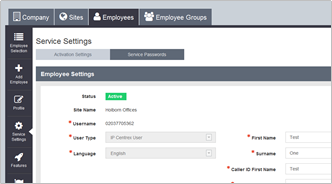
Employee Settings
By default you able to change the following settings on this page:
- Firstname – Users first name
- Surname – Users last name
- Call ID Firstname - The first name that is displayed to other parties during calls that you place or receive.
- Caller ID Surname - The last name that is displayed to other parties during calls that you place or receive
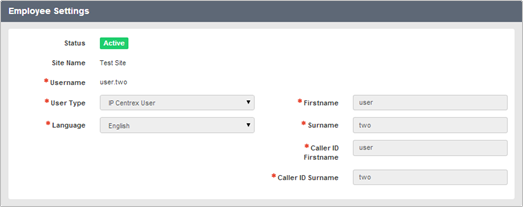
However if the CP has enabled ‘Config & Reg’ (Adds, Moves and Changes) for this Company, then Company/Group Administrators will be able to make changes to the following User settings:
User type – Specifies the type of user.
- IP Centrex User — standard Hosted Centrex User
- Business Trunking User — Hosted SIPT Employee - SIPT provides the Employee with connection to their PBX and in some cases advanced feature over and above the PBX
- Additional Line — an additional phone line for an existing Employee which will create this on the same phone.
Language- Your preferred language.
Any other setting not listed here cannot be changed.
Primary Number
By default this section is informational only and displays what telephone number and extension number the CP Administrator allocated to the User when they were created on Business Zone:

However if the CP has enabled ‘Config & Reg’ (Adds, Moves and Changes) for this Company, then Company/Group Administrators will be able to Modify the following User settings:
- Number – change the telephone number of the User by selecting Change followed by selection of a number from the available range.
- Extension – change the extension number of the User
Feature Package
By default, this section is informational only and displays what Line Pack (User feature pack) the CP Administrator allocated to the User when they were created on Business Zone:


However if the CP has enabled ‘Config & Reg’ (Adds, Moves and Changes) for this Company, then Company/Group Administrators will be able to Modify the following User settings:
- Feature Pack – downgrade or upgrade a User’s license pack
- Term – upgrade a User’s term
Optional Add-On Feature Packages
By default, this section is informational only and displays what Add-On Features the CP Administrator allocated to the User when they were created on Business Zone:

However if the CP has enabled ‘Config & Reg’ (Adds, Moves and Changes) for this Company, then Company/Group Administrators will be able to Modify the following User settings:
- Applications – enable or disable any existing user applications. Please be aware both of these have billing impacts.
Devices
Use the options provided to Modify the Employee’s Primary Device, by selecting one that has already been created under the Site:

If you are using the Additional Line feature, whereby you are wanting to add another line to an existing Users phone, then ensure you select that existing device. If you select New Device, you must choose the appropriate device type from the Device Type field and fill in the MAC Address (required).
Resubscribe a User
Resubscribe allows you to control when/if you will roll-out new features to existing Users. In order to resubscribe a user, and make any new features appear, a CP Administrator would have needed to have re-subscribed the Company and Site beforehand.
If instructed to resubscribe a user, you simply need to scroll down to the bottom of the page and select the Save button from within Service Settings, this will then reconnect to the server to check for any new features. During this process the user’s status will changed to Pending, before moving to Complete, approximately 1 minute. Once completed, simply navigate to the features page and search for the new feature.
If the CP has enabled ‘Config & Reg’ (Adds, Moves and Changes) for this Company, then Company & Group Administrators

When you deactivate an Employee’s service activation, the Employee no longer has the ability to use any of the features of the service. You can, however, re-activate the service for the Employee again at a later time, but will need to choose a new phone number. Deactivation of a User on a 1 Year or 2 Year term may incur early termination charges so please ensure you have agreed this with the CP Administrator.
To deactivate:
- Select your Employee
- Select “Service Settings” and scroll to the bottom of the page.
- Select “Deactivate”.

When the service activation has been removed, the Status column displays “Inactive”. This activity typically takes 1-2 minutes. When the User is deactivated the following happens:
- User license is revoked and turned off, and service is disabled
- Users access to the BP and any add-ons is revoked
- The telephone number is returned to the Site number pool
- The uses telephone device and MAC address is removed from the user and removed from the Site Device management page
Please note, to ensure the device is ceased from the service, ensure the user’s device is active against the user, i.e. do not change the device to no device. If you do remove the device before the Cease, when we cease the user, the phone will not be removed from the Site.
Deactivation will remove the billing cost, but will leave the users details there.

- Locate the Employee
- Select the Employee by ticking the box next to them
- Scroll to the bottom of the page and select “Delete”.
- This will instantly remove the User and there is way of recovering these details now
Please note, if a user is Ceased from Business Zones, then they will simultaneously deactivated and deleted at the same time, and thus will not appear in the Business Portal.
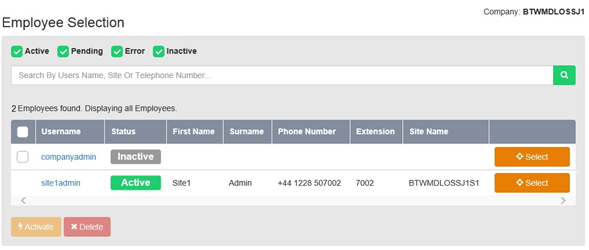
Service Settings – Service Passwords
As an Administrator, you can use the Business Portal to change your Employee’s passwords on their behalf or they can manage these themselves under their ‘My Account’ tab:

The following passwords can be changed:
- Application - Changing the Application password changes the password that Employees use to access the Applications associated to them, e g. UC Office, Toolbar etc.
- Voice Portal Pin (numbers only) – this is their Voicemail PIN and Voice Portal passcode

As an Administrator, you can use the Business Portal to change your Employee’s features on their behalf or they can manage these themselves under their account login. No hierarchal precedence is set when features are changed, so if a User makes changes, after an Administrator has, the User ones will be the ones activated.

The Features are categorised in the following categories:
- Mobility – Subject to the Feature Package ordered, this category will allow you to configure the features that allow call mobilityg. Call Director, Remote Office etc.
- Call Control - Subject to the Feature Package ordered, this category will allow you to configure the features that allow call control g. Call Forwarding, Call waiting etc.
- Contacts - Subject to the Feature Package ordered, this category will allow you to configure the contacts and directories related features g. Personal Contacts, Phone Services or Speed Dials.
- Messaging - Subject to the Feature Package ordered, this category will allow you to configure the Employees Voicemail, Fax Messaging features etc.
Features Assignment
Select this tab to remove features from a User:

As a Company Administrator or Group Administrator, you can use the Employee Feature Assignment page to view the features that have been assigned to your Employees. You can also change these assignments, making features available or unavailable to individual employees as required.
The changes you make to the feature assignments for a given Employee only applies to that Employee. If you disable a specific feature, it is not available for use by that Employee. Similarly, only features that are currently enabled can be configured using the Employee Feature Settings page. When you disable a feature, all corresponding configuration capabilities are also disabled. You can change an Employee’s feature assignments at any time.
If you are a Company Administrator, you can view and edit feature assignments for any of your Employees. If you are a Group Administrator, you can only view and edit feature assignments if you have been granted administrative privileges for a Group that is being used to represent one of your Company’s Sites.
To assign or remove features, or to permit or deny a Group Administrator the right to make changes, select or clear the check boxes in the “Allow Admin Privileges” list.
Use this option to change device settings and/or add a new device:

Please note for SIPT devices it will just display as per the screen shot below
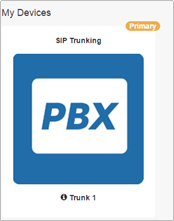
Each Employee will have a device associated with them to enable them to make and receive calls. The Shared Call Appearance 5 feature (subject to feature pack ordered), allows an Employee to have up to 5 additional devices associated to them. This allows incoming calls to ring on all of the devices simultaneously and outbound calls can be made from any one of the associated devices, all using the associated single telephone number.
The device that is ordered with the Employee on Business Zone is the “Primary Device”. All associated devices are considered alternate locations and are “Shared Call Appearance Devices”. Please note that a softphone application is considered a device and will be listed under “Devices”:
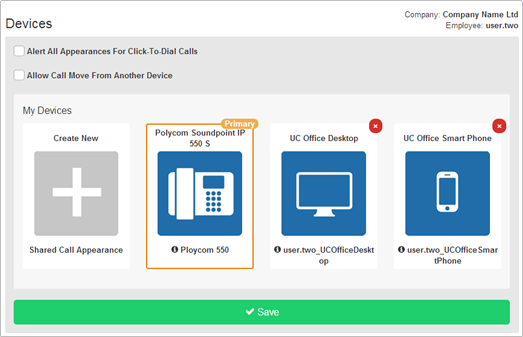
You can add a new device by selecting Create New Shared Call Appearance. This will allow you to add an “Existing Device” available under the Site or add a completely “New Device”. Please refer to the Site section of this guide for information on adding new devices.
The following options can also be set against each device:
- Alert All Appearances For Click-To-Dial Calls - When enabled, your primary and SCA (Shared Device/s) locations are alerted for a Click to Dial call.
- Allow Call Move From Another Device- This allows you to dial a FAC (Feature Access Code - Call Retrieve and Call Director Call Move - *11) to retrieve an existing active call from another location (Shared Device/s):
Applications
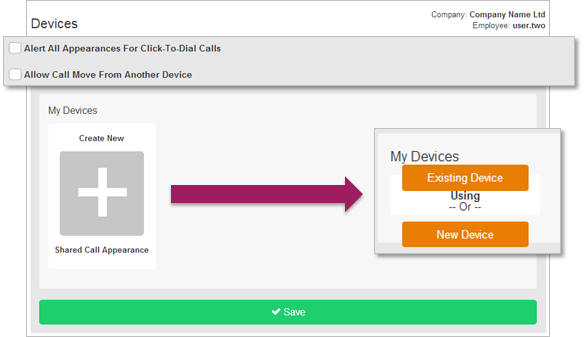
Select this tab to see what Applications are available to an Employee:

Within this page we list the Application Username for reference and offer the opportunity to change the password. Changing the password for applications does not generate an email, so you will need to pass this to the Employee if it is changed here. Alternatively the Employee can do this themselves under their Business Portal login.
On this page you or the Employee can also download the Apps by either downloading directly to their PC/Mac or via the Apple App Store or Google Play:

Select this tab to manage which Group(s) the Employee is a member of:

From this page you can see:
- All Groups
- Groups of Which This Employee Is A Member
- Groups Of Which This Employee Is Not A Member.
If you want to add the Employee to a Group then simply place a tick in the box and hit Save. Alternatively you can remove them from a Group by removing the checkbox against the Group, followed by Save.
For Group Creation, Managing a Group or Deletion of a Group refer to the “Creating and Managing Groups” in this guide.
This area allows you to manage which Group(s) the Employee is a member of.
Select this tab to see what administration privileges the Employee has:

By default, Employees with the Group Administrator role have privileges that allow them to manage Employee accounts and Groups. However, these privileges are only enabled when the Group Administrator is assigned to a specific Group.
If you are a Company Administrator, you can assign Group Administrator users to any Site or Group within your organisational hierarchy. If you are a Group Administrator, you can assign other Group Administrator users to any of the Groups you currently manage.
When you assign a Group Administrator to a Group, the administrative privileges extend to all sub-groups contained within the Group. These privileges do not extend upward within the Group hierarchy. You can change a Group Administrator’s Group assignments at any time:
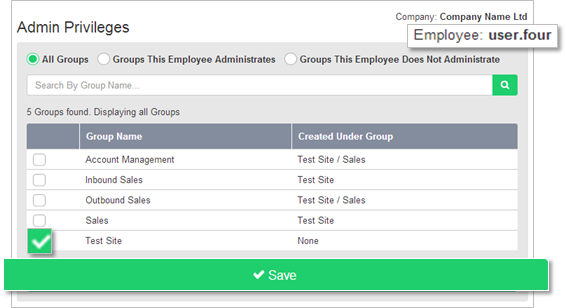
Filter Groups by selecting the top radial buttons - All Groups, Groups This Employee Administrates and Groups This Employee Does Not Administrate.
By default, this section is informational only and cannot be used.

However if the CP has enabled ‘Config & Reg’ (Adds, Moves and Changes) for this Company, then Company/Group Administrators will be able to use this feature to speed up User creation. This is done by importing a CSV (comma separated values) template. You can download the .CSV template by selecting the “Download Template” button. Once you have imported your Employees, by selecting the “Status” button, you can view the progress of the Import Job.
Employee Imports
The Employee Import process includes the following:
- File Type – Custom Template (.csv) is recommended

- File Encoding – This is pre-populated.
- File – Browse and select your .CSV file you wish to upload.
- Job Name – Give the Job/Task a name.
- More Options – Select:

- Schedule – Start now or select a future date and time.
- Method - Add New Users or Update Current Users
- Priority – Low, Medium, High
- Usernames - This option only applies to .csv imports where usernames are not already defined.
- Mode – “Run In Test Mode” is recommended for first time users to test the Job before submitting.

Please note Import is creation of Users only and does not include activation. Each User will need to be activated separately on the Business Portal and the following applied to each User:
- User Type
- Feature package
- Feature Add-ons
- DDI/Extension
- IP Device (New or Existing)
To “Activate” your Employee follow the below listed steps:
Click the “Search”
- If you have many Employees to activate, qualify the search as required e.g. enter part of the username.
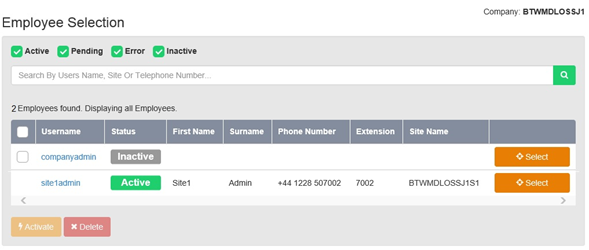
Select the check box(es) alongside the Employee(s) you wish to activate.
- You can select more than one check box if you want to activate more than one User.
Select “Activate” and follow Employee Creation and Activation steps detailed earlier on in this document.

